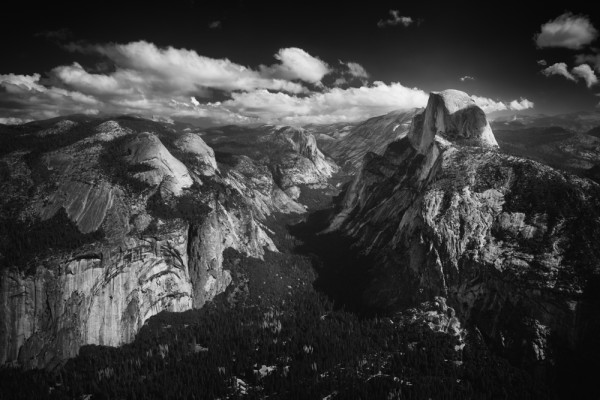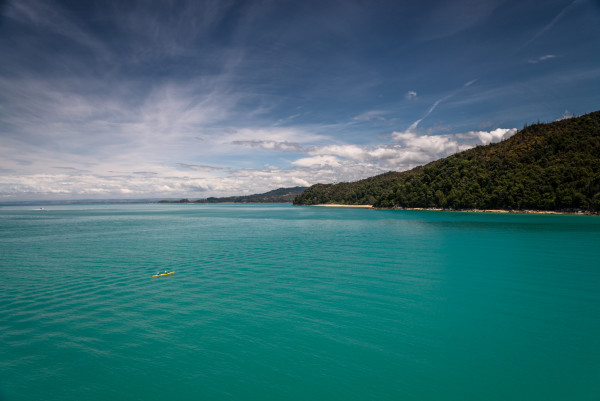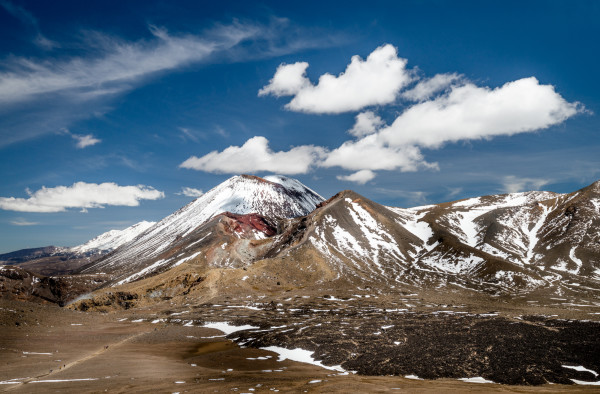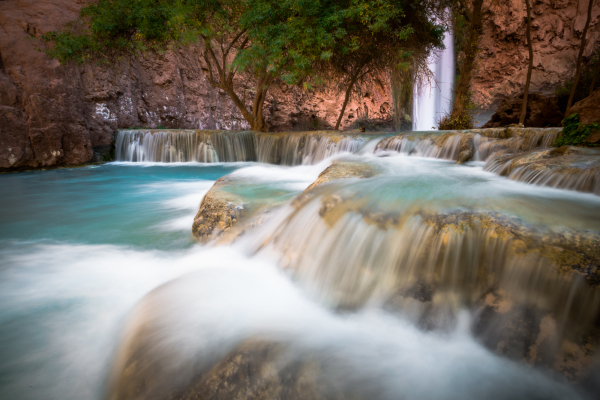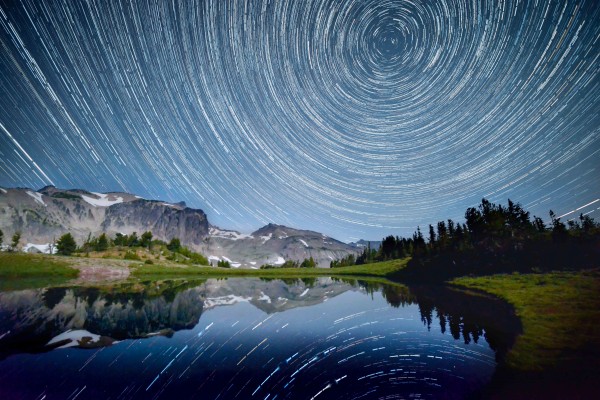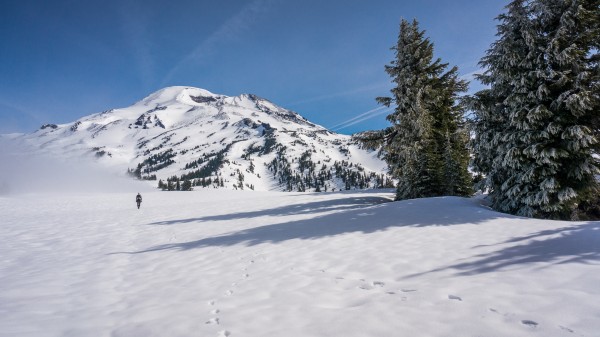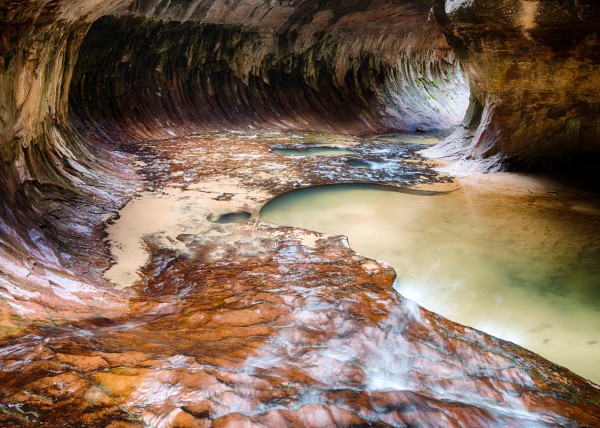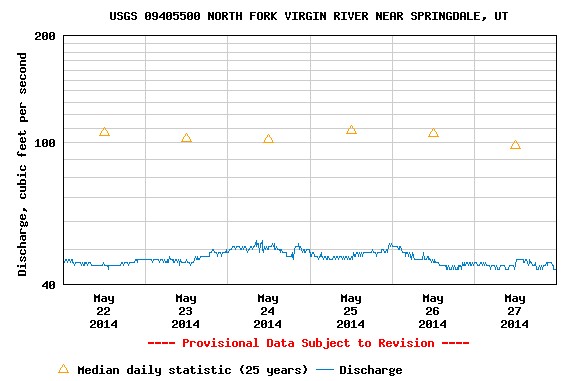12
2016There are volumes written about the hike to Half Dome along with some videos from the park service, so I won’t cover the hike in detail. Suffice it to say, it’s a long day… about 16 miles and 5000 vertical feet of elevation gain. Anne and I both got over 55,000 steps on our Fitbits. We got started early and were on the trail by 7am, expecting a full 12 hour day.
Starting from the valley floor you gain elevation steeply and steadily as you first pass Vernal Falls and then Nevada Falls. We took the “Mist Trail” that was anything but; both waterfalls were a trickle of their normal selves. Once the top of Nevada Falls is attained, you’re a little less than halfway to the summit dome. The path wanders casually through the Little Yosemite Valley before beginning a long and fairly relentless climb to the top of sub dome, punctuated briefly by a flat and beautiful forest.

Once we broke out of the trees we could see that the weather, which had been overcast all morning with a 15% chance of rain, had actually moved in around us and snow began to lightly fall. As we got to the top of sub dome, we talked with several people and watched those climbing and descending to determine if it was safe to head up. We’d almost made the decision to make the climb when folks on the cables started yelling to everyone to head down, so we aborted plans.
A note here about gear. Most people on the cables didn’t have any gear except gloves. Anne and I both brought harnesses and via ferrata leashes to ensure our safety in the event we or someone else fell. Given the consequences, I was honestly appalled at how many people seemed completely unprepared to be safe especially given the rapidly changing conditions.
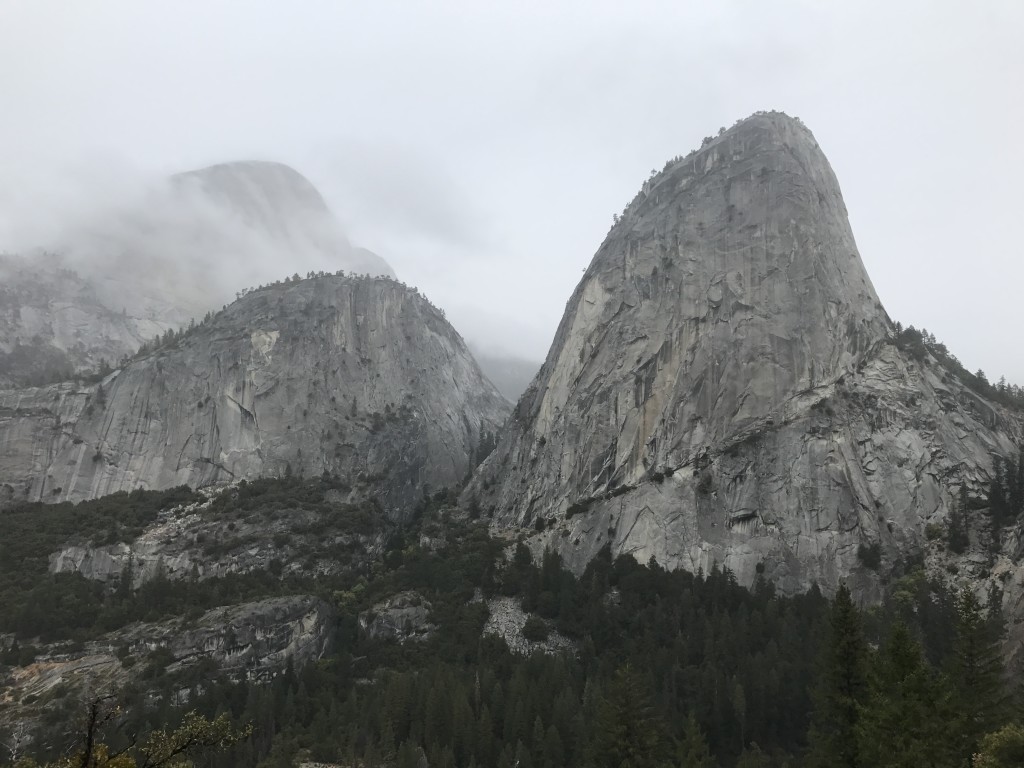
The hike to the valley was uneventful and long, with light snow and then light rain. Conditions on the top of Half Dome continued to deteriorate, making both of us happy we decided to turn around instead of continue and leaving a nice goal for our next trip to Yosemite.
Max elevation: 8412 ft
Min elevation: 4037 ft
23
2016Six months ago or so Anne put in for permits to climb Half Dome and we were able to get a climbing slot on October 3. So we set out planning a Yosemite trip around that date, secured the necessary camping reservations, and planned a camping trip for the Van we knew would be coming mid summer. The plan basically looked like: Leave Friday, get to Yosemite Saturday night, explore Sunday, climb Half Dome Monday, hit the Tuolumne Meadows area, see Mono Lake, and maybe climb Lassen on the way back.
Lower Pines
We camped the first three nights in Lower Pines campground. The location was close to the Half Dome trailhead and provided some pretty spectacular morning scenery.

Glacier Point, Sentinel Dome, and Taft Point
Sunday was our first full day in the park and we tried to do easy hiking at elevation to help us acclimatize to the altitude of the park. We started with the view at Glacier Point and then used the afternoon for some short hikes.
Sentinel Dome is a short hike with small elevation gain that leads to an easily climbed granite dome offering superb views up and down the valley.
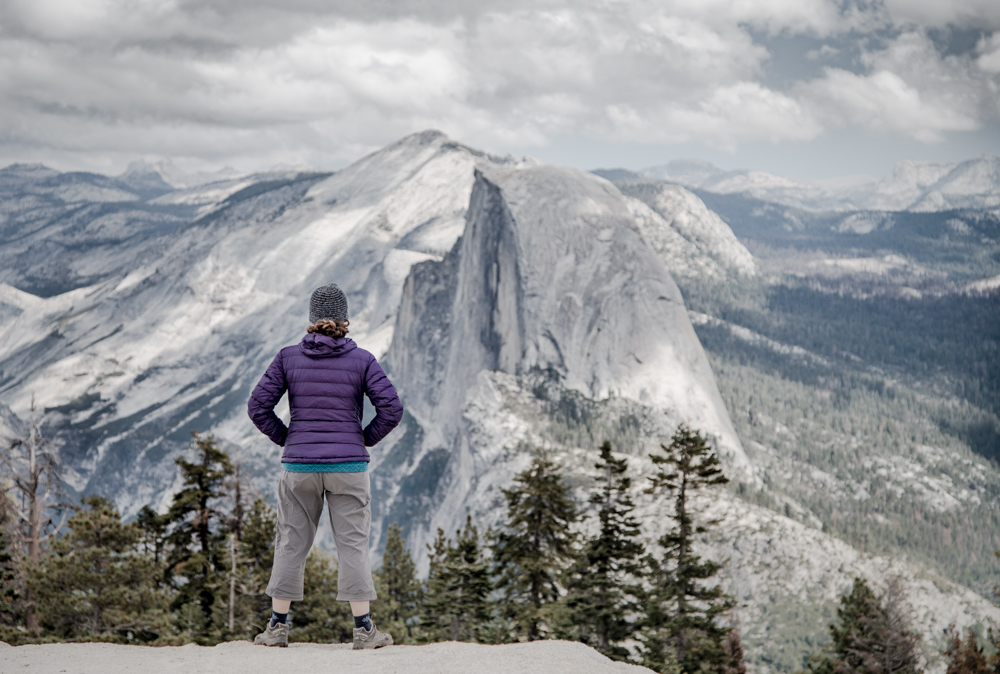
Anne looking at Half Dome from Sentinel Dome
Taft Point is another short hike from the same trailhead that yields extraordinary views of El Capitan and offers abundant opportunities to look straight down to the valley floor (not for the feint of heart).
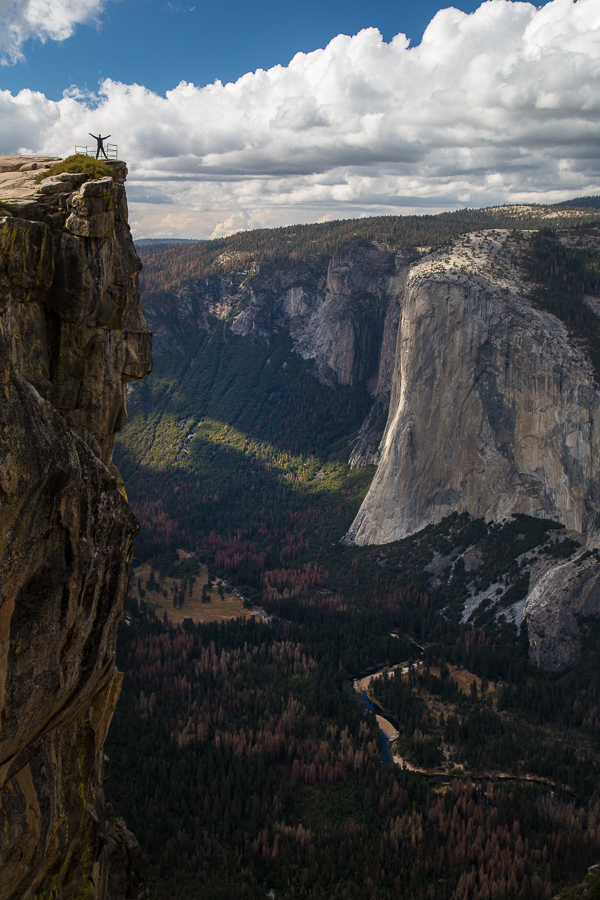
Nate at Taft Point (photo by Anne Archambault)
We concluded the day with dinner in the van and a surreal sunset at Washburn Point.
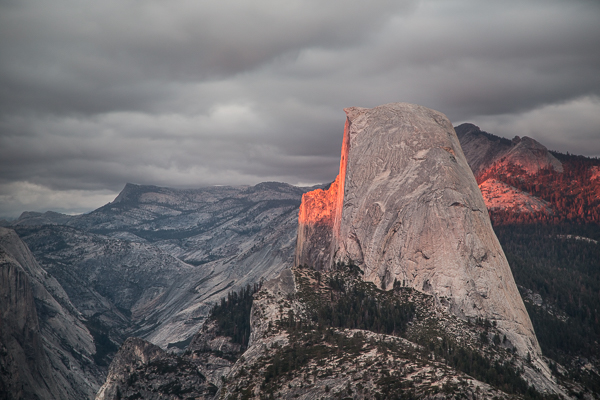
Half Dome from Washburn Point at sunset (photo by Anne Archambault)
06
2014There are several “Great Walks” in New Zealand that receive very positive reviews in guidebooks and online. The Abel Tasman Track is one of these walks that generally receives “not to be missed” praise. It is in fact the most popular Great Walk in New Zealand. Located in the Abel Tasman National Park on the South Island’s northwest coast, the walk extends roughly 56 km from the start at Marahau to the end of the track at Wainui. Anne and I did a shortened version of the trip over 4 days in December (6-9) from Marahau to Totaranui covering 41.4 km.
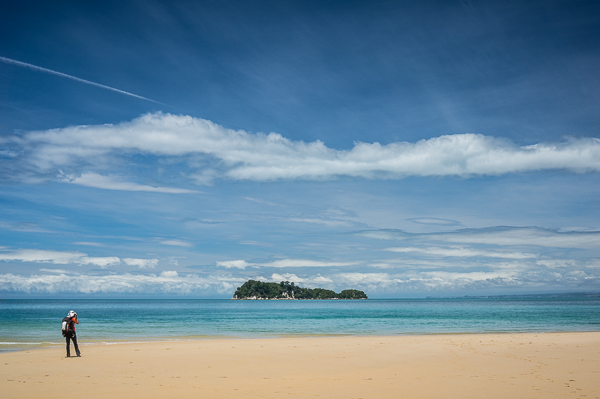
(photo by Anne Archambault)
The track mostly follows the coast line, sometimes on beach but mostly on very well maintained trails in the forest overlooking the Tasman Sea. The myriad streams and small canyons along the way are bridged — some with impressive suspension bridges. In two places, there are relatively significant tidal crossings that can only be done within an hour or two of low tide.
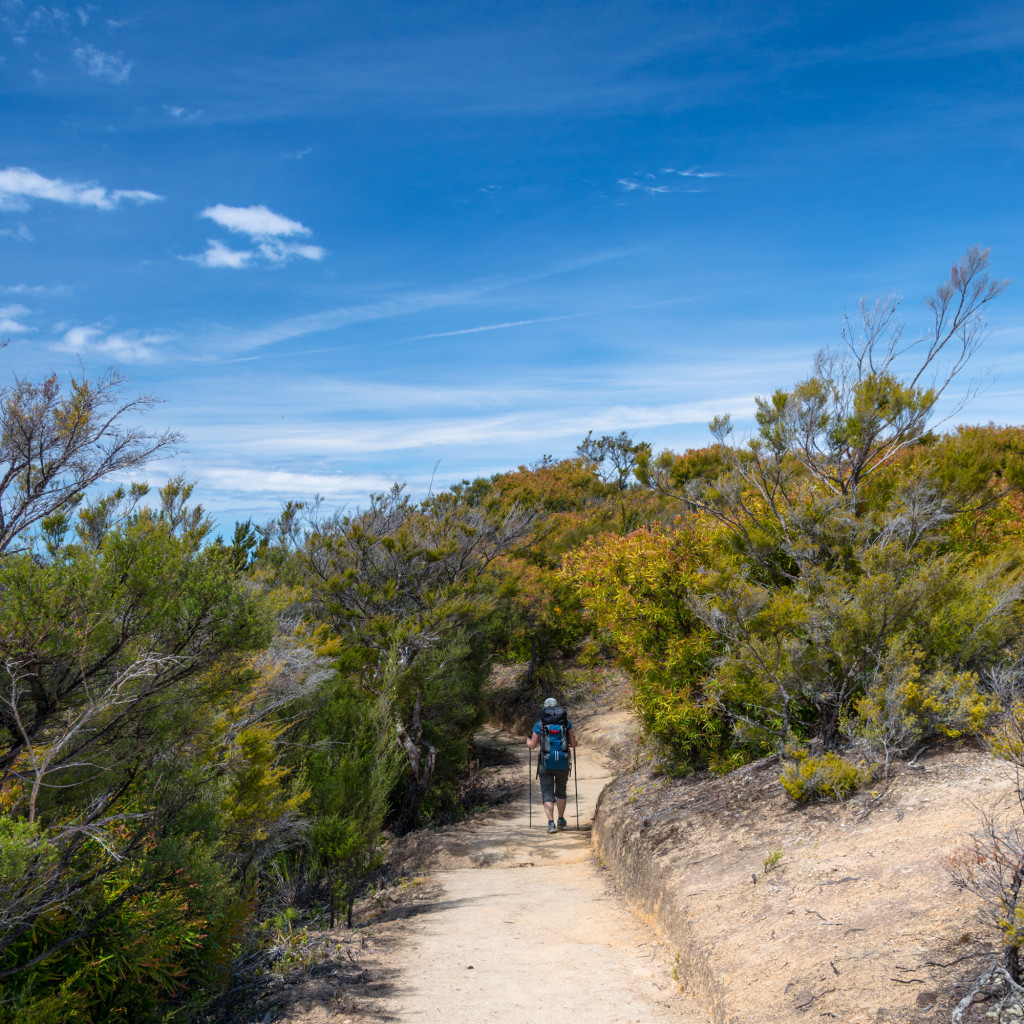
Overnight accommodation is provided in both Department of Conservation (DOC) huts as well as campgrounds. The huts must be booked well in advance and provide drinking water, toilets, and sleeping pads in bunk style dorm rooms. The length of the track (through Totaranui) is serviced by water taxi, which allows hikers to access any point along the trail easily. This is a blessing and a curse, it allows for myriad options to explore the trail, but also allows scores of day trippers to visit huts and campgrounds that would otherwise be 2 days from the trailhead.
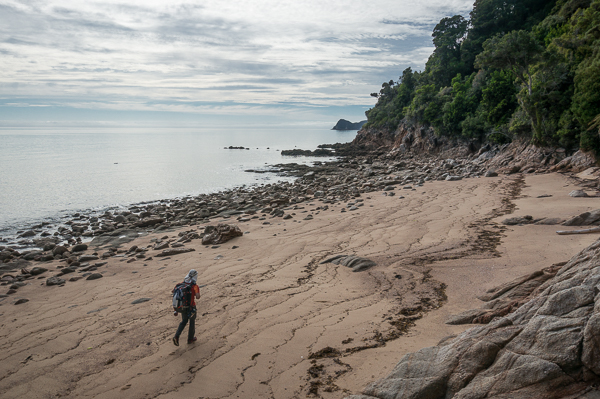
(photo by Anne Archambault)
Beaches and Beautiful Blue Water
The highlight of the track is the proximity to the beautiful beaches and pristine blue water of the Tasman Sea. Without knowing better, it would be easy to mistake the coastline for beaches in Thailand or Hawaii.

In some places, rocky granite outcroppings form small islands just offshore. These provided a wonderful opportunity for us to take a break from the walk and pull out the camera gear. We didn’t use the tripod often, but in these cases it was very handy for long exposure compositions.
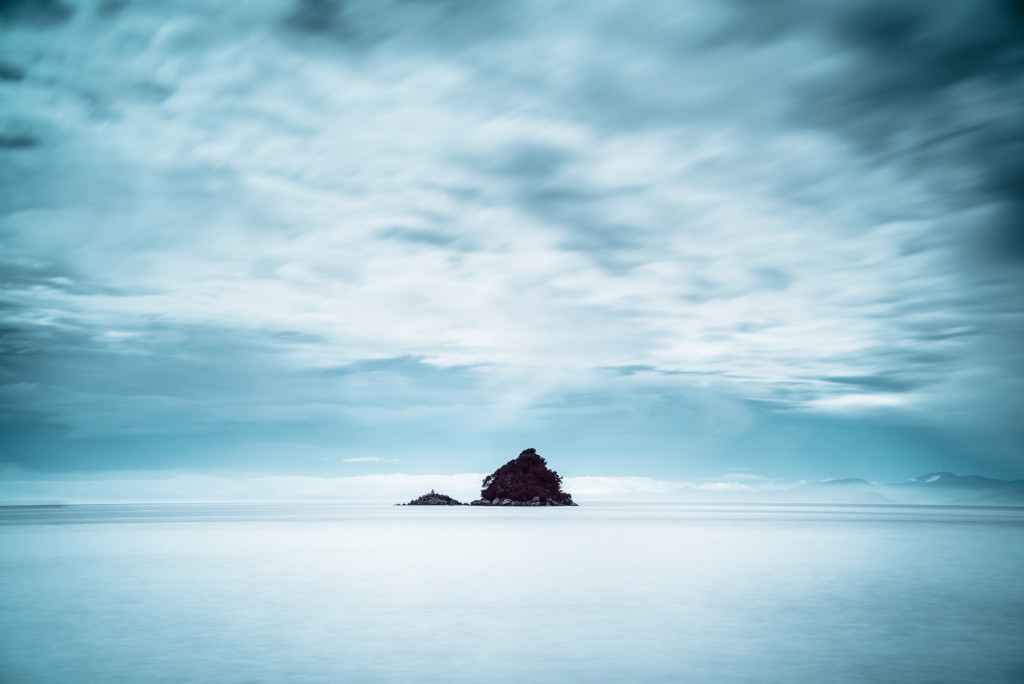
Because of the way the hike is laid out, Anne and I were generally able to complete our hike by early afternoon, giving us plenty of time to rest and relax at the hut. Alternatively, many hikers took the opportunity to stop along the way at secluded or otherwise wonderful beach locations and relax.
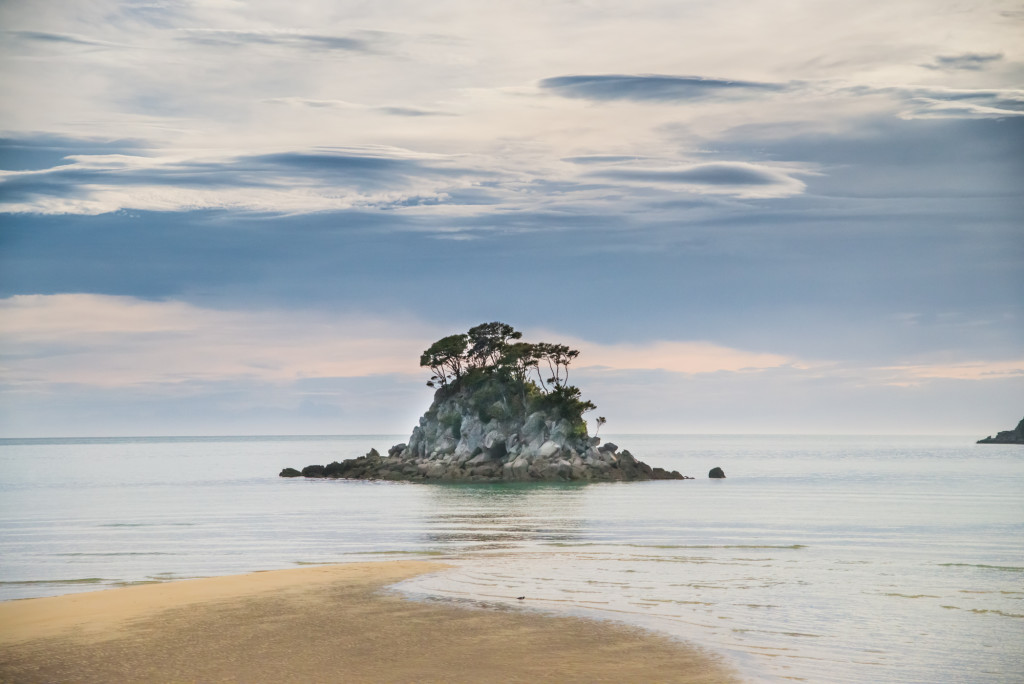
Of course the beaches also provided wonderful sunrise and sunset photography. At Anchorage Bay, we had to be up at 5am to make the tidal crossing and were able to watch an amazing sunrise bloom over the hills.
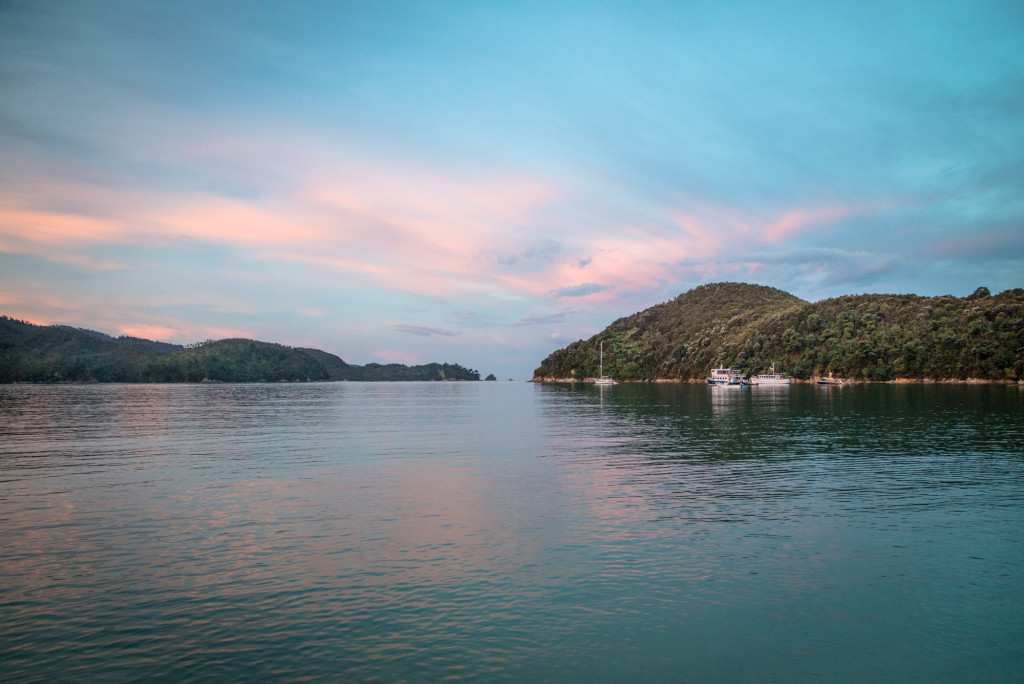
Wildlife
The national parks we visited on the South Island all had robust conservation efforts in place to help protect indigenous species. Invasive species such as possums, rats, and stoats have decimated the native bird populations. Along the track are literally hundreds of traps designed to kill these predators.
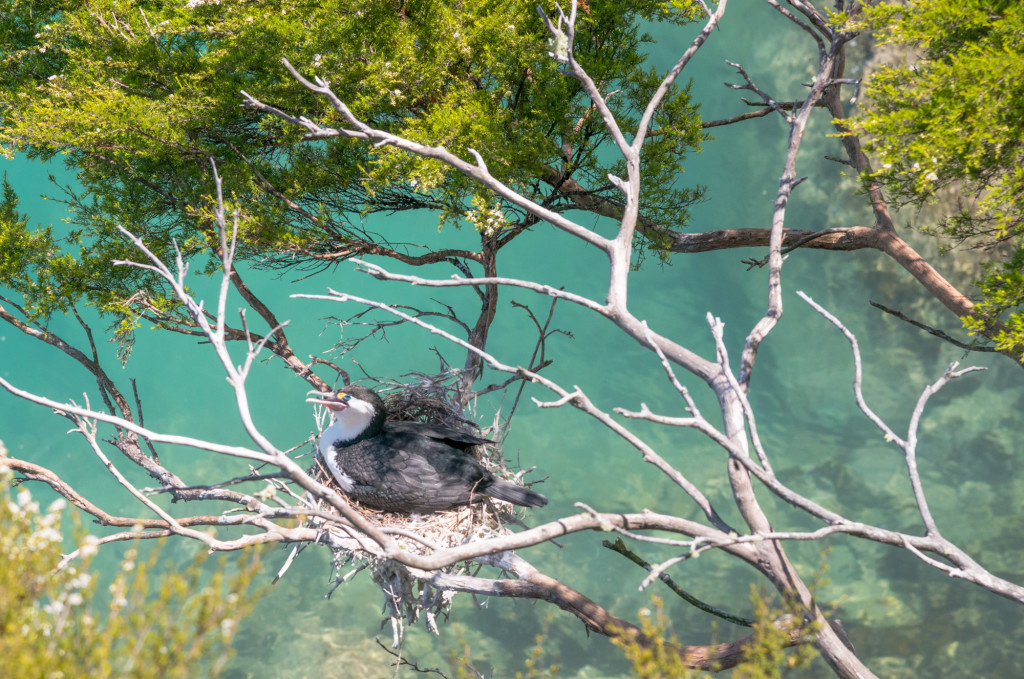
Many of the islands visible along the track are sanctuaries where native species can nest in relative safety. There is also the Tonga Island Marine Reserve to help protect dolphins, seals, and the many native species that inhabit the diverse system of waterways, estuaries, and bays. Fur seals come here to lay their pups and penguins sleep along the rocky headlands.
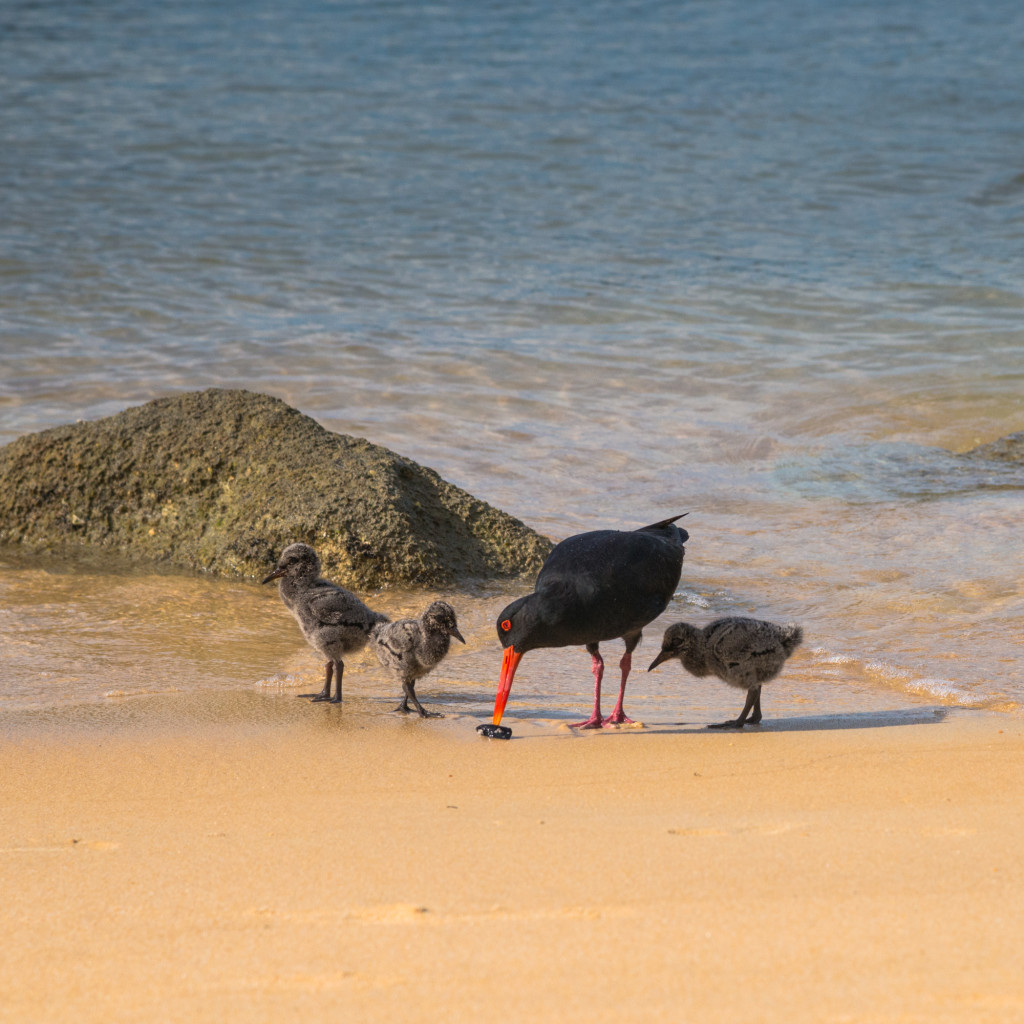
Because we were walking the track in the southern hemisphere’s summer, we were also able to see a lot of young chicks. At Anchorage Bay, a pair of variable oystercatchers had a set of three chicks that allowed us to approach during low tide.

We also saw many of the native quail, some with broods as large as 6 or 8. Some of these quail were quite tame and even posed a little.
Incredible Flora
It’s hard to discount the incredible flora of New Zealand. In Abel Tasman National Park, the forest is dominated in the undergrowth by ferns both small and large. Tree ferns and beech form the bulk of the forest canopy, punctuated by fragrant flowering manuka trees (famous for their honey).
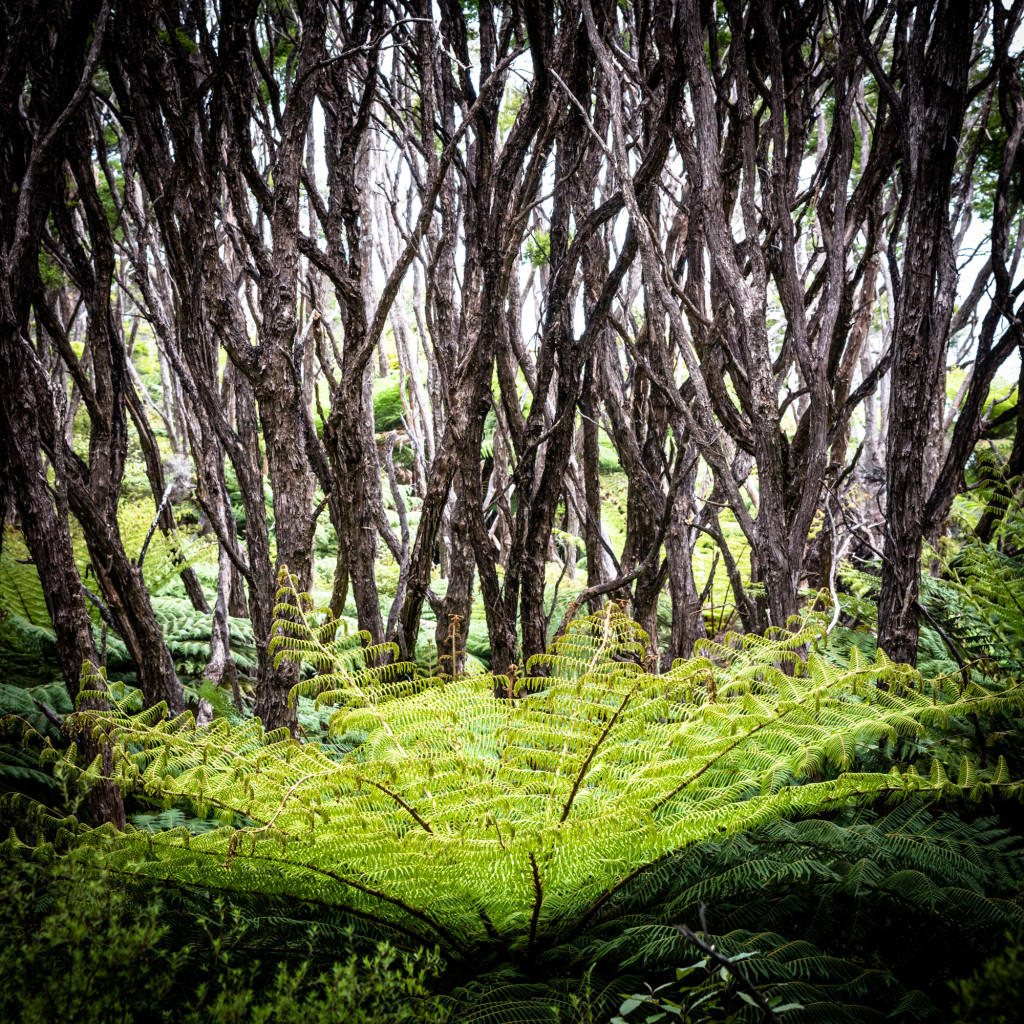
The ferns lend a prehistoric feel to the forest and you could be forgiven for thinking you might be walking on the set of Jurassic Park. In fact, we talked to one person who was sure they filmed some scenes from the movie in the park.
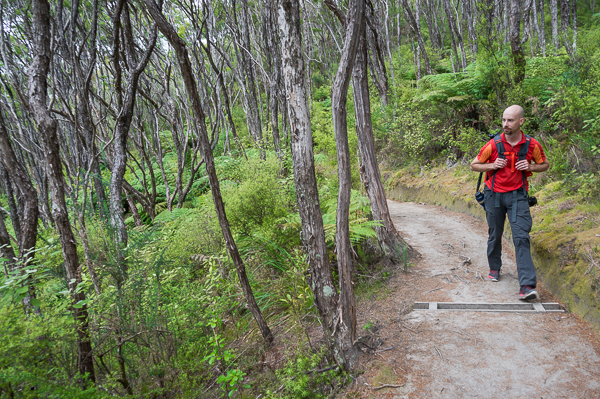
(photo by Anne Archambault)
Should you go?
In short, yes. The trail is fantastic, the days are short, and the scenery is well worth it.

The trail is a little more crowded than other tracks, both because of the relative ease and the easy access. It’s a great warm up for longer or harder walks and it’s also great for families (of which we saw many).
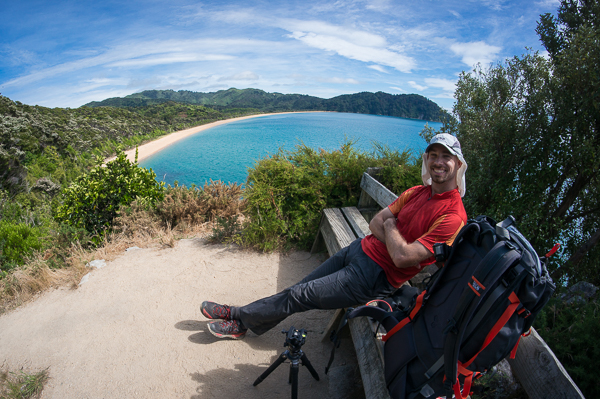
(photo by Anne Archambault)
And who could argue with lots of time on the beach? Anne and I both felt like 4 days was plenty; it provided enough time to get into the backpacking groove without feeling like we were spending more time than we should (the south island is big, we didn’t want to miss anything).
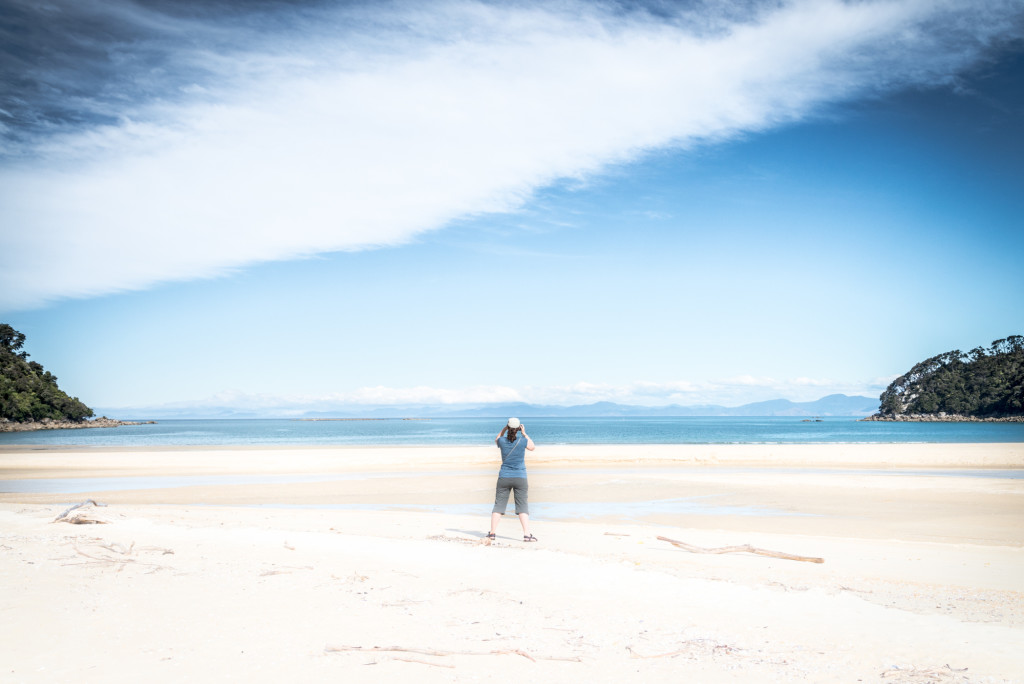
Max elevation: 385 ft
Min elevation: -283 ft
03
2014As part of our vacation in New Zealand, Anne and I had a set of “Great Walks” planned. One of those was the Tongariro Northern Circuit that circumnavigates the beautiful volcanic cone of Mt. Ngauruhoe (also known as Mt. Doom in the Lord of the Rings movies). The Northern Circuit is normally a four day walk serviced by DOC huts. However, the weather forecast for the days we had booked was terrible; gale force winds, rain, and a low cloud ceiling which would have precluded any views of the mountains. So we changed plans, looked for a weather opening, and did the one day crossing instead.
The Tongariro Alpine Crossing is billed as one of the greatest day hikes in the world, and I think Anne and I would be compelled to agree that it’s certainly high on the list. Between the well maintained trail and the incredible views it really is a winner. The only drawback was the sheer number of people also doing the crossing, which on the day we made the crossing must have been in the hundreds.
The hike from the trailhead up to Soda Springs crosses sub-alpine scrub, following the course of a small stream. The trail here is exceptional and well graded with many areas having full boardwalks. Views up to Mt. Ngauruhoe only improve with each step.
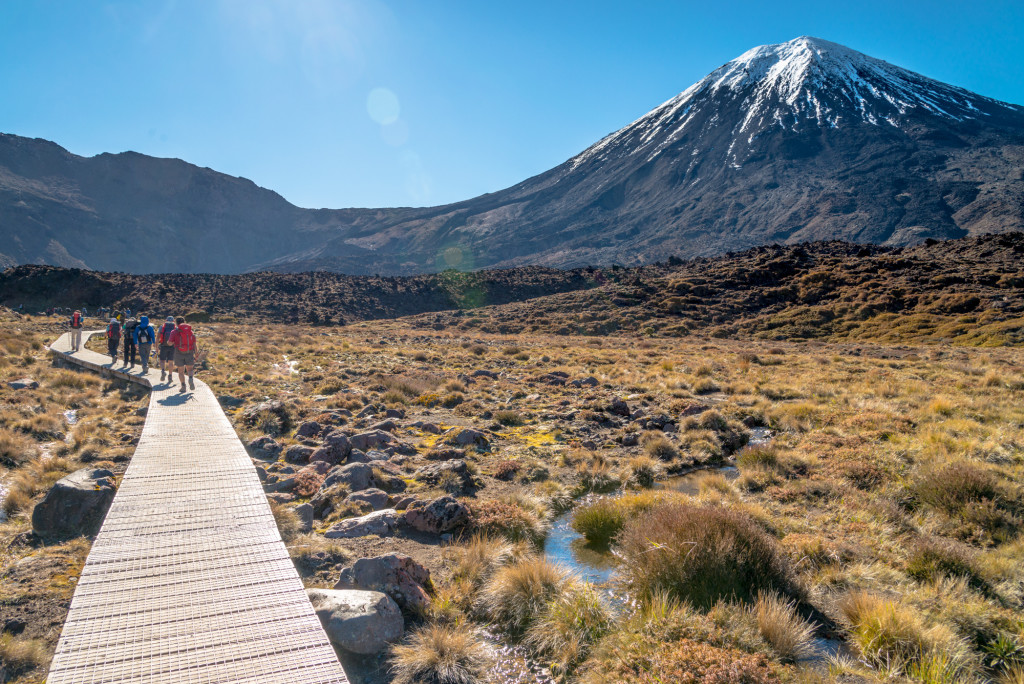
From Soda Springs, the trail climbs steeply up to the South Crater entrance. While steep, this path is still excellent with most of the trail formed into actual stairs. Gaining in elevation, we were able to see Mt Taranaki standing sentinel over New Plymouth some 50 or 60 miles distant. The trail quickly gains elevation, traversing the flank of Ngauruhoe and entering the South Crater where the summit path up Mt. Ngauruhoe branches off.
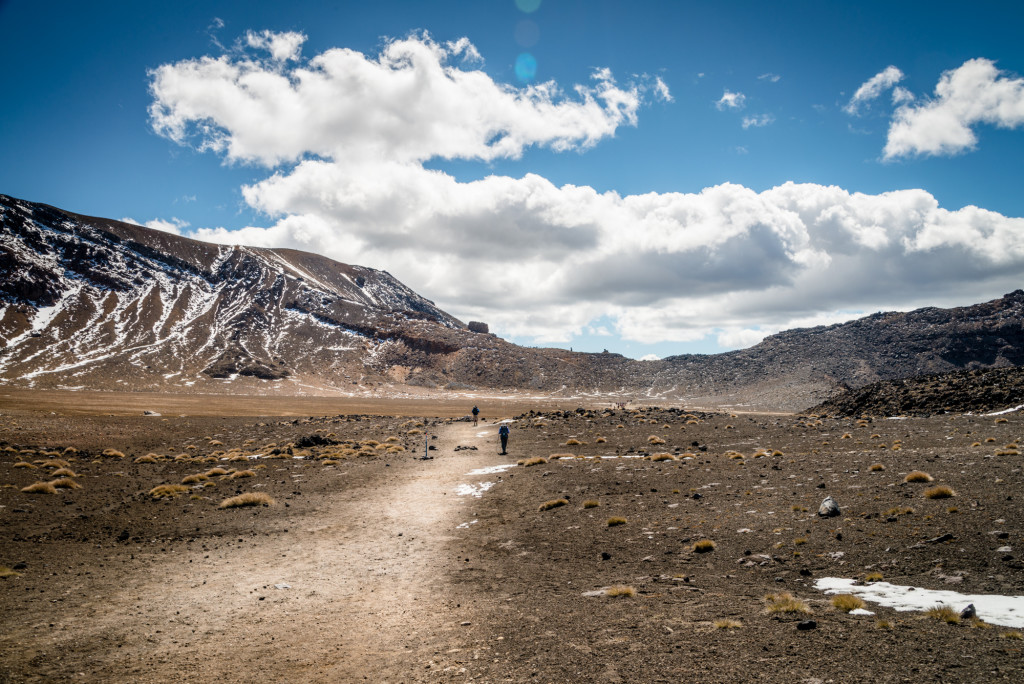
The Alpine Crossing trail continues across the South Crater, which is actually thought to be an in-filled glacial cirque rather than an actual volcanic vent where it climbs again, more steeply, to gain the top of the red crater.
[jwplayer mediaid=”1665″]
Anne and I took the side trip to the summit of Mt. Tongariro. This was a relatively short detour with limited elevation gain but it provided extraordinary views over the South Crater and across to Mt. Ngauruhoe. The summit rewards hikers with outstanding views in all directions. I think it’s a detour that should not be missed.
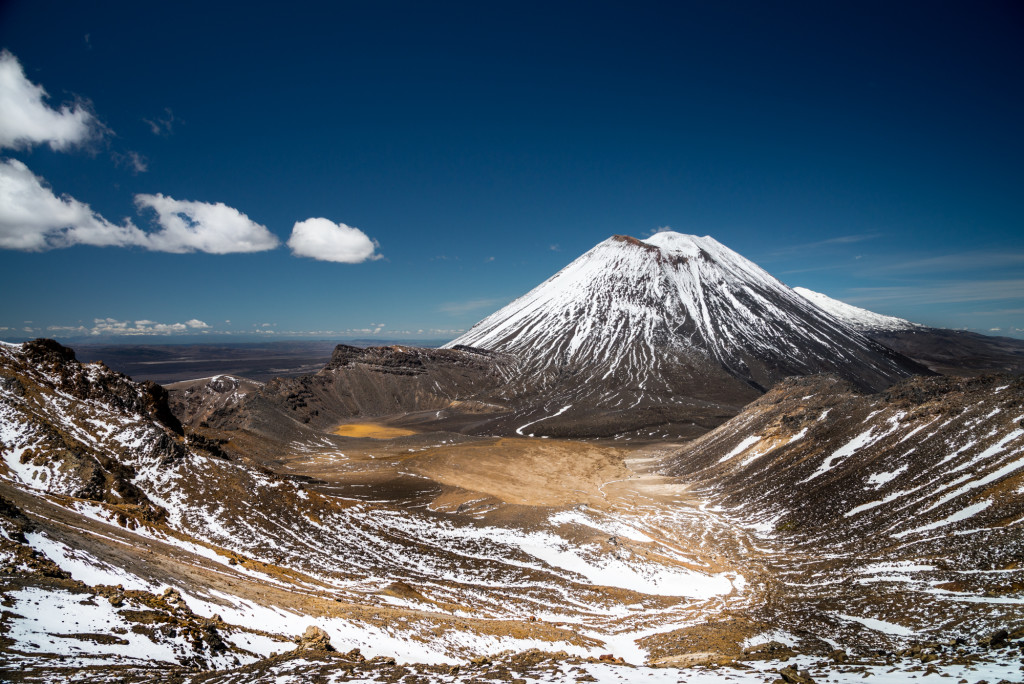
Back on the main trail, the path climbs slightly to a viewpoint over the Red Crater before descending steeply down a very loose volcanic scree slope to the Emerald Lakes.
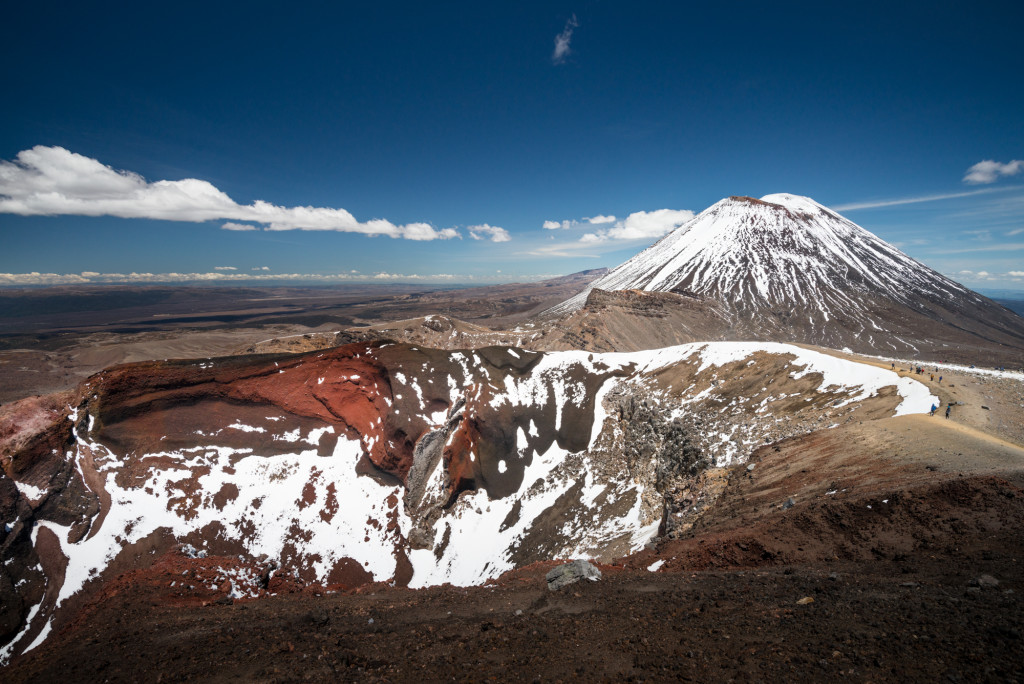
Hikers should take note that at this point the hike is about halfway done, though virtually all of the uphill has been completed.
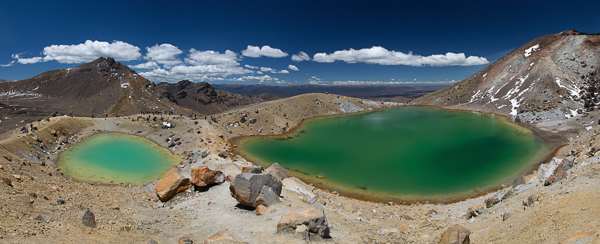
A hike across the Central Crater followed by a short climb brings hikers to Blue Lake, which is actually another crater that’s about 9700 years old. This serves as a wonderful vantage point back across the Central Crater and Mt. Ngauruhoe, which is now partially occluded by the Red Crater and the shoulder of Mt. Tongariro.
The rest of the hike from this point is relentlessly downhill to the Ketetahi Car Park. The trail passes through the active volcanic zone of Te Māri crater where an explosion in 2012 left a hole in the Ketetahi Day Shelter that is still on display.
From the shelter to the car park the trail winds first through alpine scrub before descending into the trees of the forest. This section of the hike is much longer than it appears on paper and should not be underestimated. We were only just able to make our shuttle pick up time 8.5 hours after drop off because we didn’t appropriately estimate how long this last section of the trail was. It should also be noted that even though signs posted times that showed us as on track, these didn’t seem to accurately reflect the time/distance towards the end of the trail. All that to say, if you do the crossing, factor in a little buffer.

In all, the Tongariro Alpine Crossing was a fantastic day hike. It’s certainly worthy of a top mention for all the day hikes we’ve done in the world, though whether or not it occupies the top slot needs some consideration.
Max elevation: 6457 ft
Min elevation: 2574 ft
11
2014Anne was in Phoenix attending the Grace Hopper conference and so we made plans with our friend Valerie (of Haute Route fame) to hike into Havasu Falls and the Havasu creek canyon. Havasu creek is somewhat unique because of the high mineral content in the water, giving it an astounding turquoise color and building up beautiful travertine pools that provide for countless smaller cascades down the length of the canyon. The beauty of the canyon certainly puts it on the “bucket list” of hiking and photographic locations to visit. So Anne and I were both super excited, both because we got to spent time with Valerie as well as because we got to do it in such a wonderful location.
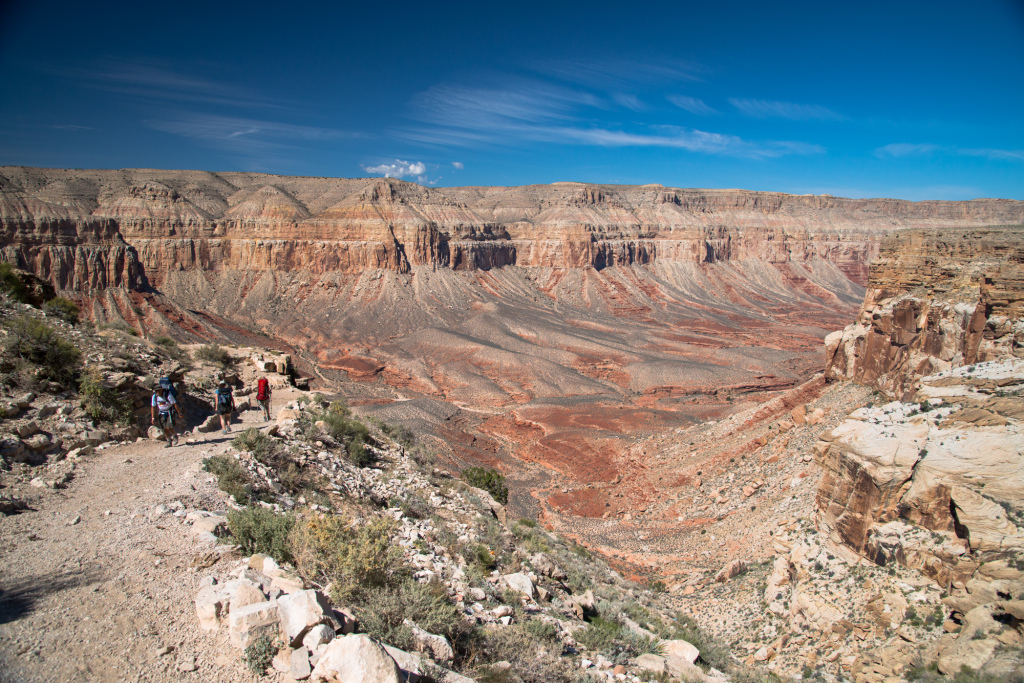
Camping reservations into the canyon are notoriously difficult to get given the popularity of the hike. However, Valerie was doggedly persistent and able to secure camping reservations by calling repeatedly until a camping space finally opened up.
On paper, the hike is not a difficult one. From the trailhead to the campground my GPS clocked 10.75 miles with 2577 feet of elevation loss. However, the statistics don’t take into account the fact that most of the trail follows a river wash with a packed gravel surface. This provides a good path, but saps energy and makes the hike feel longer than it might on a firmer packed surface.
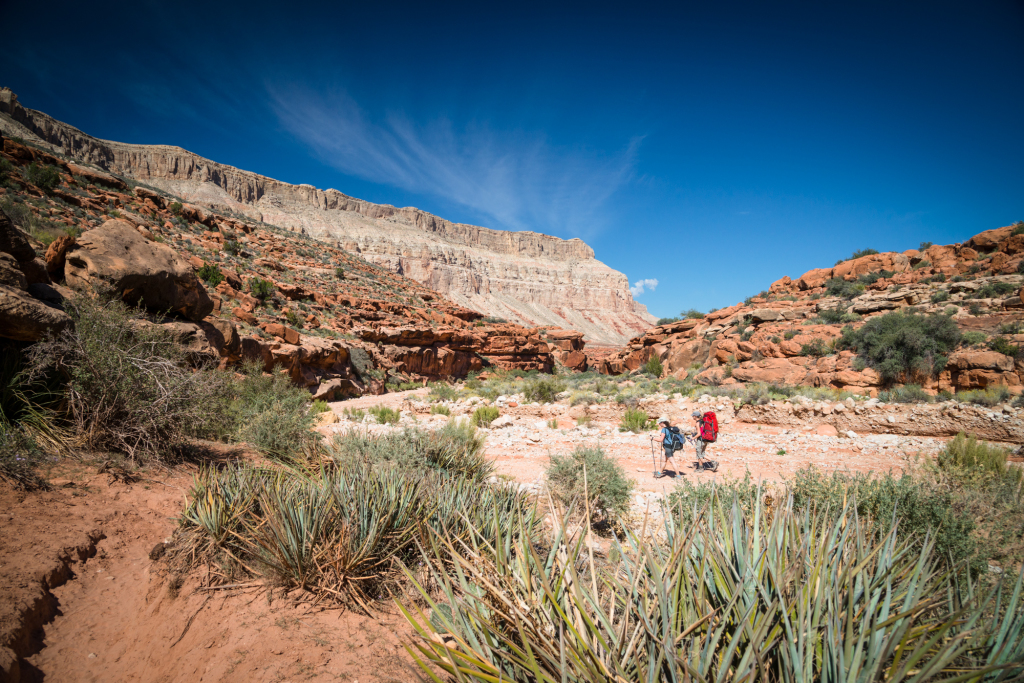
We started our hike on Saturday morning and arrived at the trailhead around 11:00 am after a relatively leisurely breakfast in Peach Springs. By that time the parking lot was already packed to overflowing, with cars parked well down the road. We rounded ourselves up for the hike quickly and set out on the hike right around 11:30 am . Luckily, the temperatures were still mild and made for a pleasant start.
The hike drops elevation quickly as it makes its way down a series of switchbacks that joins a gentle ridge taking you down into the bottom of the canyon to the creek bed. This trail then winds its way very gently downhill, following a river bed to the town of Supai.

Along the dry creek bed, there are often braided trails that shortcut horseshoes in the creek and help facilitate both horse and human traffic. Plenty of horse droppings help confirm continually that you’re on the right track. Surprisingly, given our late start, the hike was a pleasant one with long sections of the trail being in partial shade. After about 3 hours, we reached a junction with a sign confirming that we were “almost” at Supai. The trail forked left and continued through a dense patch of trees where we first crossed Supai creek. Shortly thereafter we descended a small hill and arrived at the village of Supai. We wound our way around town and stopped at the Camp Reservations building (about 7.4 miles from the trailhead) where we picked up our camping permits consisting of printed wrist bands for each member of the party as well as a tent tag for each tent in the group.
Note to hikers: There is a water spigot at this building where you can fill your water bottles.
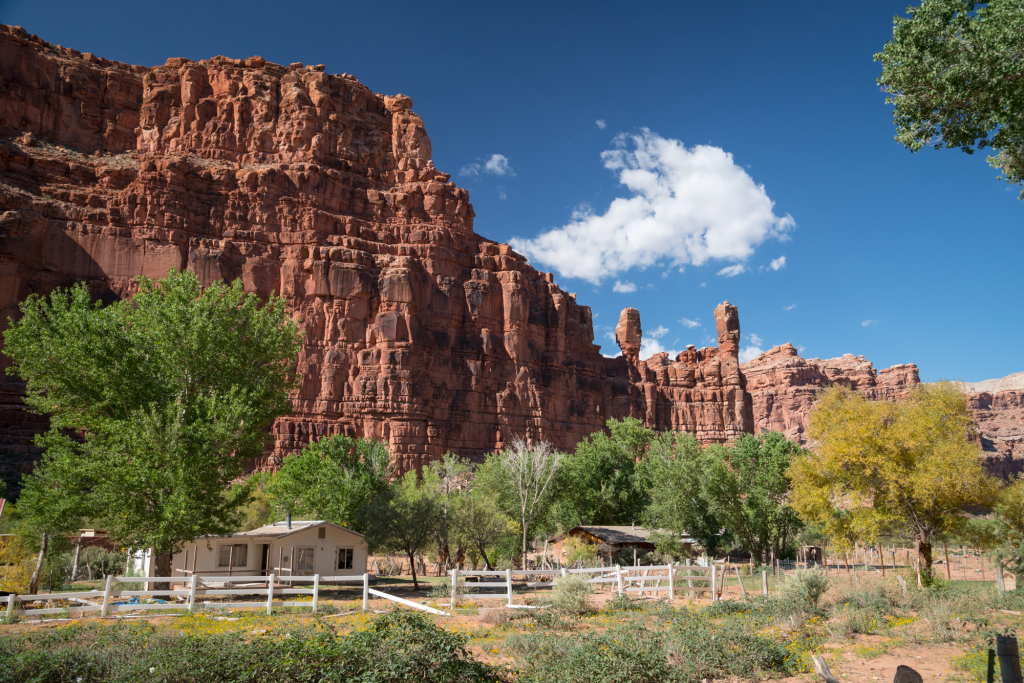
The trail leads quickly out of town to parallel Havasu Creek, which then again quickly brings you to your first set of small but beautiful travertine cascades.

Not far beyond is Havasu Falls and the campground. We’d read about the campsite before we left and steered past the start of the campground, instead looking for sites after about the second bathroom. However, the campground was almost completely full with people which made campsite selection difficult. In the end, we wound up with an excellent, secluded spot next to the creek at the very far end of the camp group (close to Mooney Falls). Total time, about 5 hours.
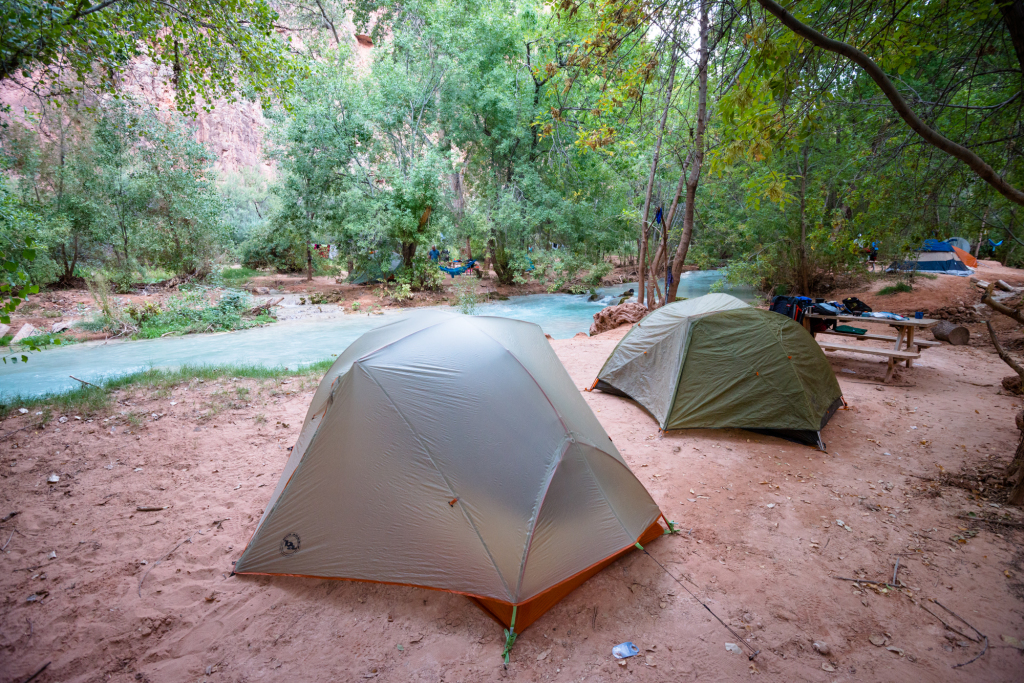
On Sunday we hiked further down the canyon with the desire to photograph Beaver Falls. Just beyond our campsite was Mooney Falls, maybe a 5 minute walk from the end of the camp group. Here the trail winds down a series of increasingly steep ledges until it finally disappears into a hole in the rock that passes through a tunnel and to a series of chains and ladders that descend to the base of Mooney Falls.
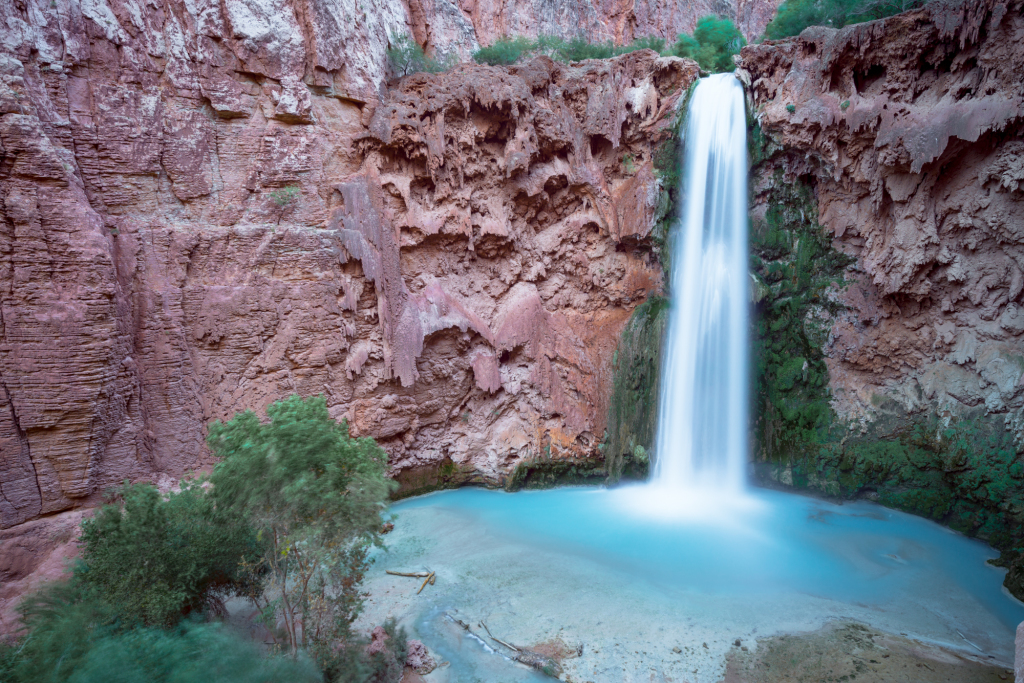
The lower section of the descent is perpetually wet from the spray off the cascade making for both muddy and slippery conditions. It’s not a particularly difficult descent, but does require care and is best done without others either coming down on top of you or climbing up immediately under you.

Mooney Falls and pools offer some really nice photographic opportunities. On the far side of the canyon from the ladders there are a nice set of travertine cascades that contrast beautifully against the red canyon walls. Get here early or late to avoid harsh sunlight.
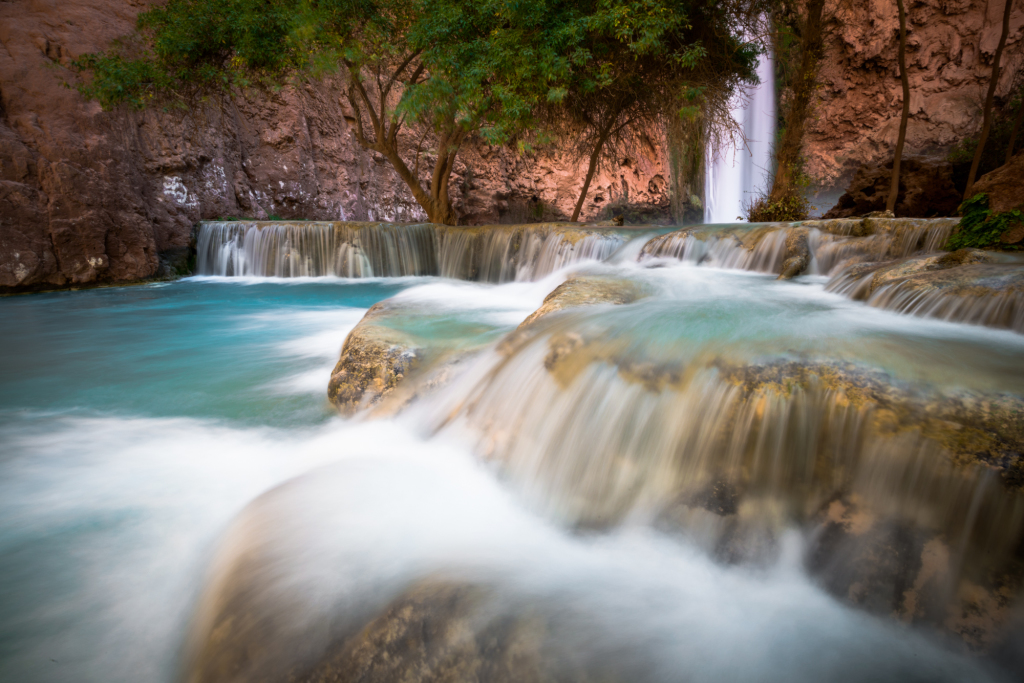
Continuing further down the canyon brings you to two creek crossings. Here you’ll need to remove shoes (or be willing to get them wet) before you can continue dry the rest of the way to Beaver Falls. Havasu Creek continues down the valley with ever present pools and falls, all robed in the beautiful blue-green hues that makes it stand out so vividly against the red rocks.
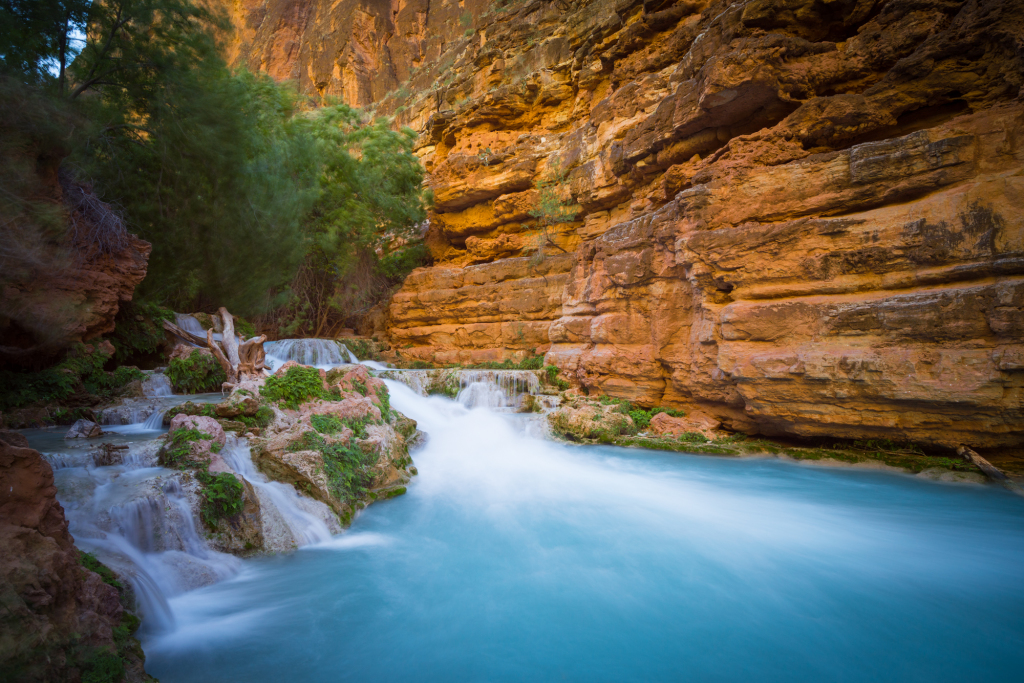
In a couple places, you ascent ladders or hewn logs to gain high trails that look down on the winding creek before finally ending at a tribal patrol station where your wrist band is checked. Before descending to the creek, you can make a short (~100 yard) detour to step inside Grand Canyon National Park and look back at Beaver Falls from a nice vantage point. It’s possible to continue another approximately 4 miles to the Colorado River.

The hike to Beaver Falls concludes with a descent down a series of three ladders where you cross Havasu Creek just under the falls. The river crossing below Beaver Falls is quite shallow and allows for easy placement of a tripod to get nice long exposure images of the falls and pool.

Notice to hikers, as we were ascending out of the falls I was hit in the head by a small rock falling from above. Thankfully, it left me with only a little pain but the consequences of such a hit could have been fatal. From that point on, I made a point of standing well clear of the canyon walls when I was able to.
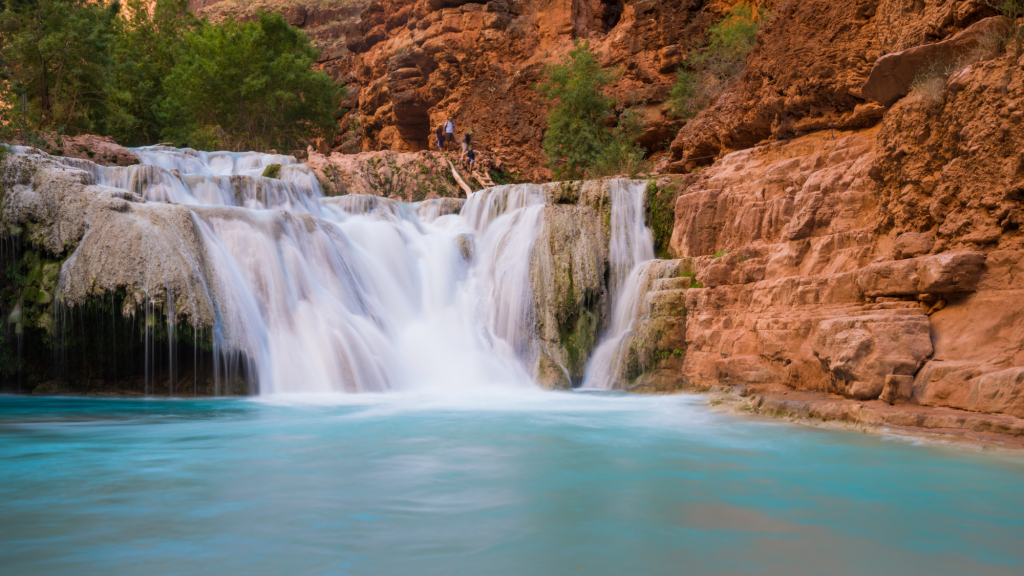
We finished the day by hiking back to camp and up to Havasu Falls to catch sundown. Havasu Falls are best photographed in the early morning or late evening to avoid harsh sunlight and high contrast. As an added advantage, by the time we got there most of the day hikers and swimmers had left.
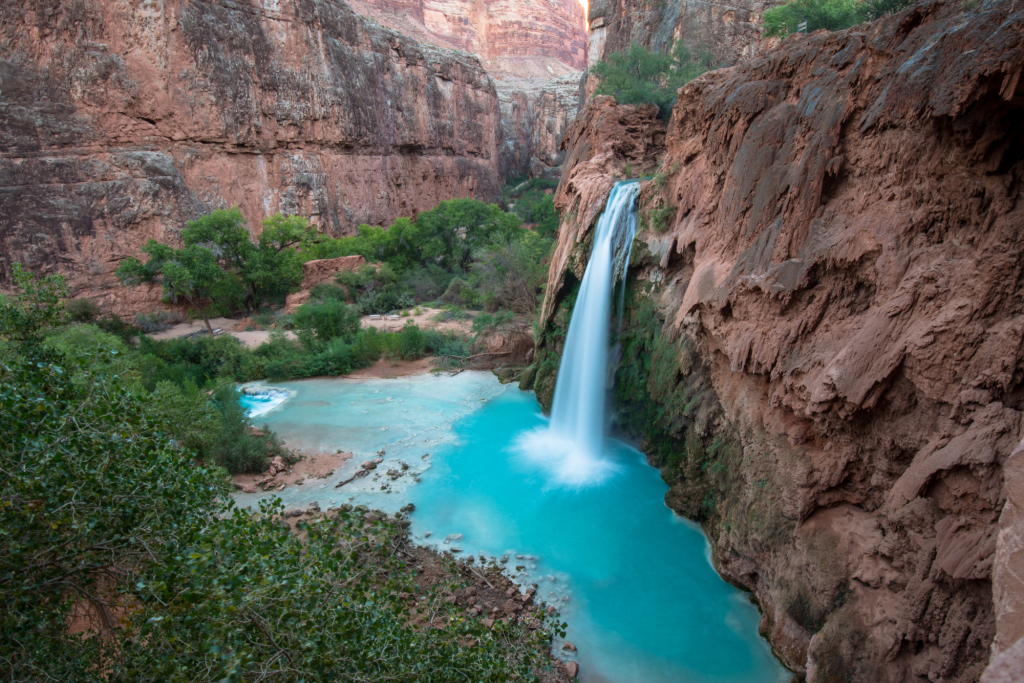
Because we had a 6pm flight out of Phoenix, we had to get a really early start on Monday morning. We woke at 4am, packed up camp, and were on the trail by 5am under bright moonlight and an incredible blanket of stars. Havasu Falls was well lit by the moon as we walked past, making for a magical scene. By the time the first sunlight was hitting the rim of the canyon we’d already passed Supai and were on our way up the wash. Because of the early start, we enjoyed cool temperatures and shade for all but about the last 30 minutes of the hike, and only about 15 minutes worth of that was in direct sunlight.
We ended the hike with sore feet and big smiles, excited about both the amazing sights in the canyon and the great companionship we shared over the weekend. Definitely a bucket lister!
Max elevation: 5236 ft
Min elevation: 2585 ft
14
2014Anne and I headed out of work as quickly as we could Friday to try and make the best out of one of the best aurora forecasts (see my other post on photographing the Aurora Borealis) in a long time. As we left Redmond, the estimated planetary Kp index was already topping 7, promising strong aurora displays overhead. Our destination, Mt. Baker. We knew that we could hit Artists Point by car, which would give us both high elevation as well as unobstructed views and dark skies.
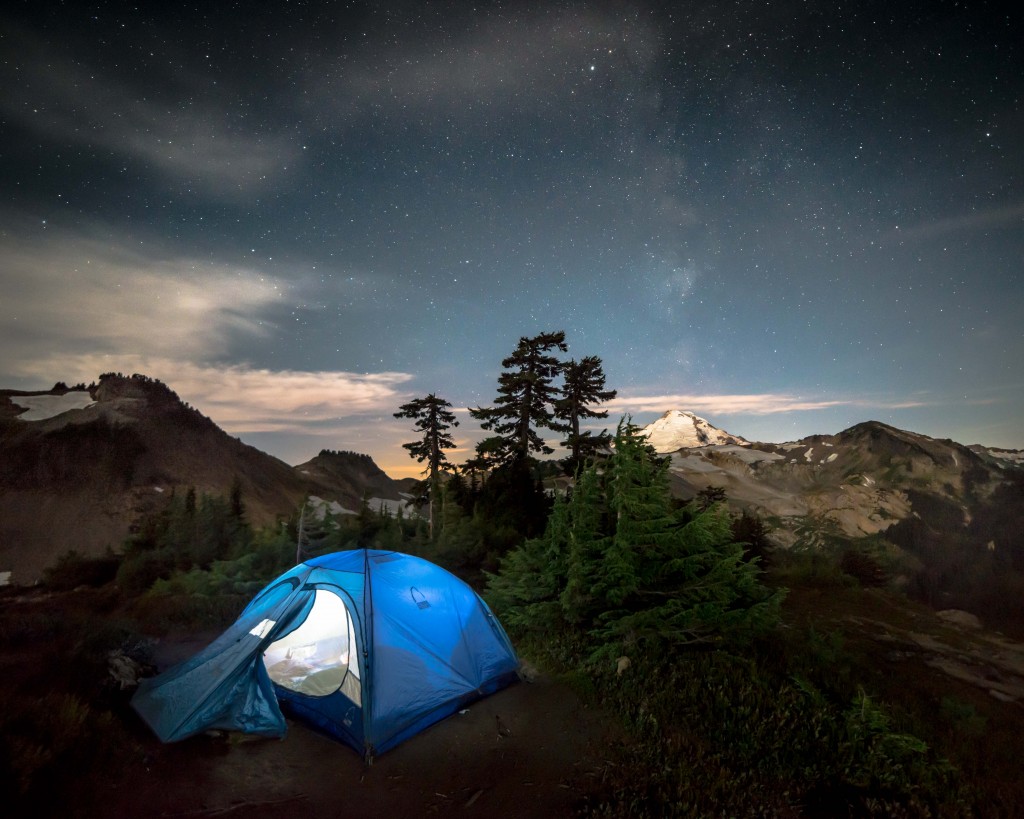
While we’d hoped to grab a campsite in either Douglas Fir or Silver Fir campgrounds, we found quickly that we were out of luck and that all camp sites were full. Undaunted, we continued to the top of the Mt Baker Highway to the Artists Point parking area where we found a party like atmosphere. The parking lot was full, the camper behind us had a fire pit going, and music was playing loudly. In 360 degrees around us, people had taken up residence on virtually every promontory and cars were coming and going by the minute.
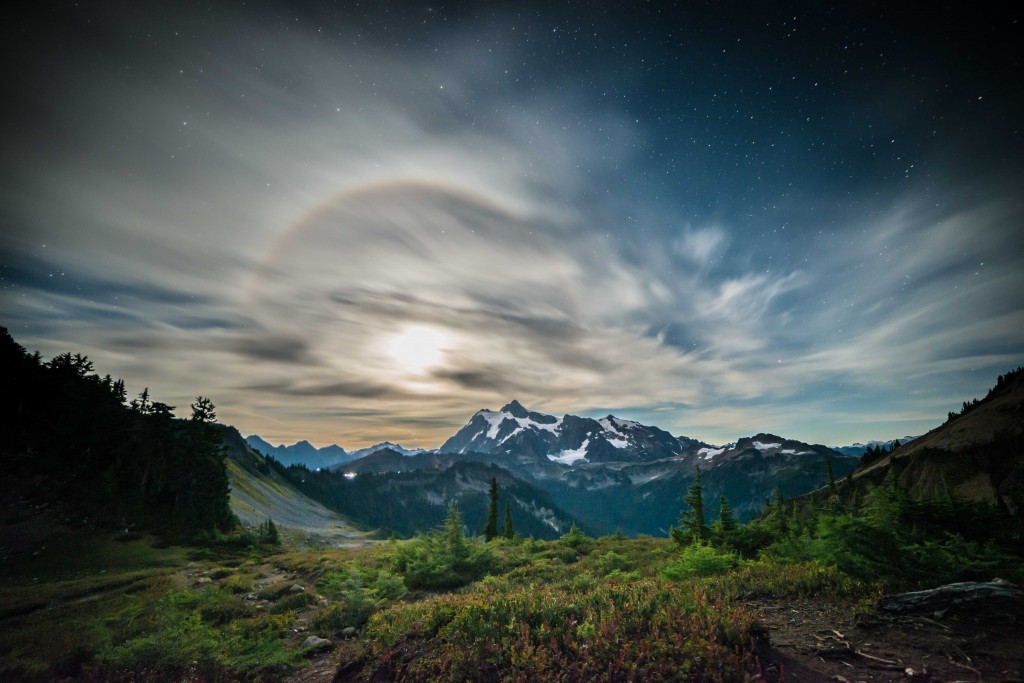
Anne and I quickly decided that in order to both have the best chance of catching the aurora as well as sleeping for the night, we’d be best to backpack out past Table Mountain and grab a campsite where we would be away from the crowds and have a place to sleep. We packed up our car camping tent, cameras, clothes, minimal food, and tripods and left as quickly as we could. The 1.1 miles to the Chain Lakes/Ptarmigan Ridge junction passed quickly and under glorious conditions and we found ourselves a camp site overlooking the chain lakes, Mt. Baker, Mt. Skuksan, and the rest of the splendor of the Mt. Baker wilderness.
We made camp and stayed up till midnight, but no aurora presented itself. Just to make sure, I left my camera out overnight to capture a time lapse, which also proved that the aurora was not to be found. Regardless, we had an absolutely wonderful night out under the stars in some of the most spectacular landscape one could wish for.
17
2014Mt. Curtis Gilbert (8184 ft) in the Goat Rocks Wilderness has been on Anne’s and my climb list for a while. Given that we hadn’t been on an overnight backpacking trip since our Zion Narrows trip and that the forecast looked promising, we decided to give it a go. Peggy Goldman’s Washington Scrambles book listed the hike’s coordinates as relatively moderate with an 8 mile/2000ft approach to Warm Lake and another 4 miles/2000ft to gain the summit. We loaded up our packs Friday night and set out early on Saturday morning for the trailhead.
For a little good karma, we picked up a hitchhiker at the Stevens Canyon Road / Highway 123 junction. This hiker turned out to be a PCT through hiker who was going for a resupply in Packwood. The amazing part – this hiker and his wife had already completed the PCT from Mexico to Canada and were headed back to the Mexico border! So even though it was a little out of our way, we enjoyed the company so much we eagerly drove him to Packwood. Sadly, we never thought to get either his name or email address. [UPDATE: It turns out our PCT through hiker’s name was Darrell “Chimp” Johnson and he unfortunately wasn’t able to complete his yoyo PCT hike because of injury. His wife, Dubliner Olive “Raindance” McGloin, ended up completing her yoyo PCT trek by herself thereby becoming the first women to do so. That’s an average of 27 miles a day for 195 days straight! What an outstanding achievement!]
We arrived at the trailhead around 12h30, ate a quick lunch, and set off across Conrad Meadows towards the Surprise Lake Trail. Conrad Meadows is the largest subalpine meadows in the Cascades. Despite trip reports of hikers getting lost by the myriad paths leading across Conrad Meadows, Anne and I (with the help of GPS) were able to chart a straight path to the official start of the trail and the permit box.
The hike was very moderate and the trail was both well-maintained (despite the heavy horse traffic) and very well graded. In fact, it seemed that we barely gained elevation at all. Anne and I took the “Old” trail that was called out in the new version of Peggy Goldman’s Washington scramble book. This in opposition to the “New” trail leading to Surprise Lake in the old version of her book.
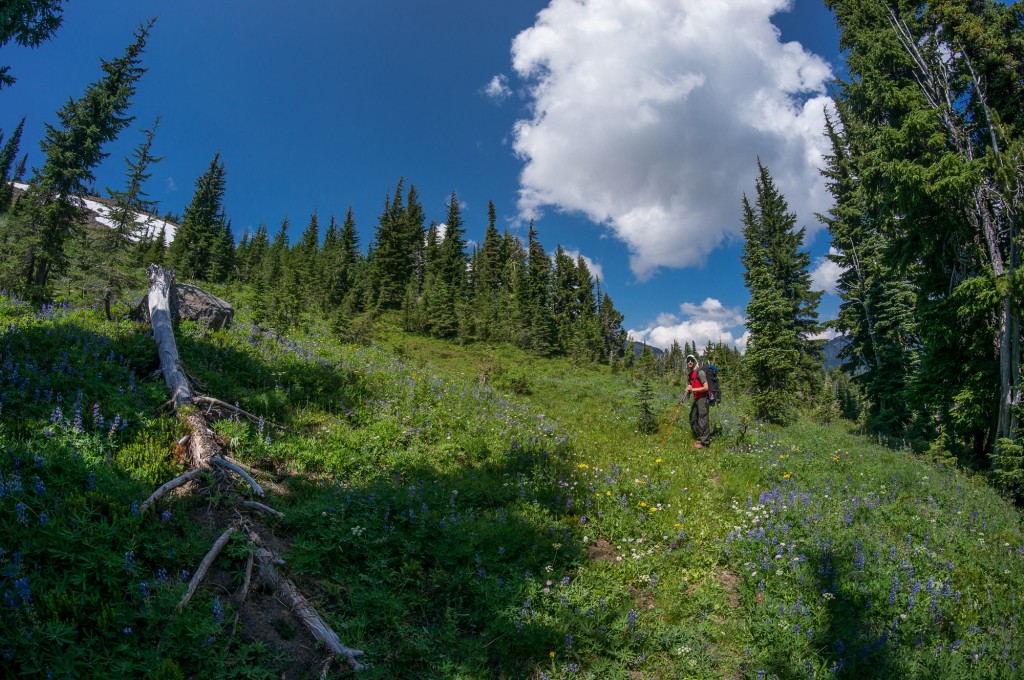
(Photo by Anne Archambault)
However, the pleasant grade changed abruptly once we reached the turn off towards Warm Lake. The path towards Warm Lake is marked by a cairn and a small path leading to the north that gains elevation steeply as it climbs away from the main Surprise Loop trail. The trail continues to gain elevation and travels (counter-intuitively) AWAY from Warm Lake until it gains a small plateau under a steep, somewhat cliffy hillside. The path continues away from Warm Lake, over the South Fork Tieton tributary, until it ascends steeply again making for a small col from which you turn left at the cairn and travel back towards Warm Lake following what could best be described as a game trail. You’ll again from the South Fork Tieton where the trail completely disappears and you continue overland up the hillside to reach Warm Lake.
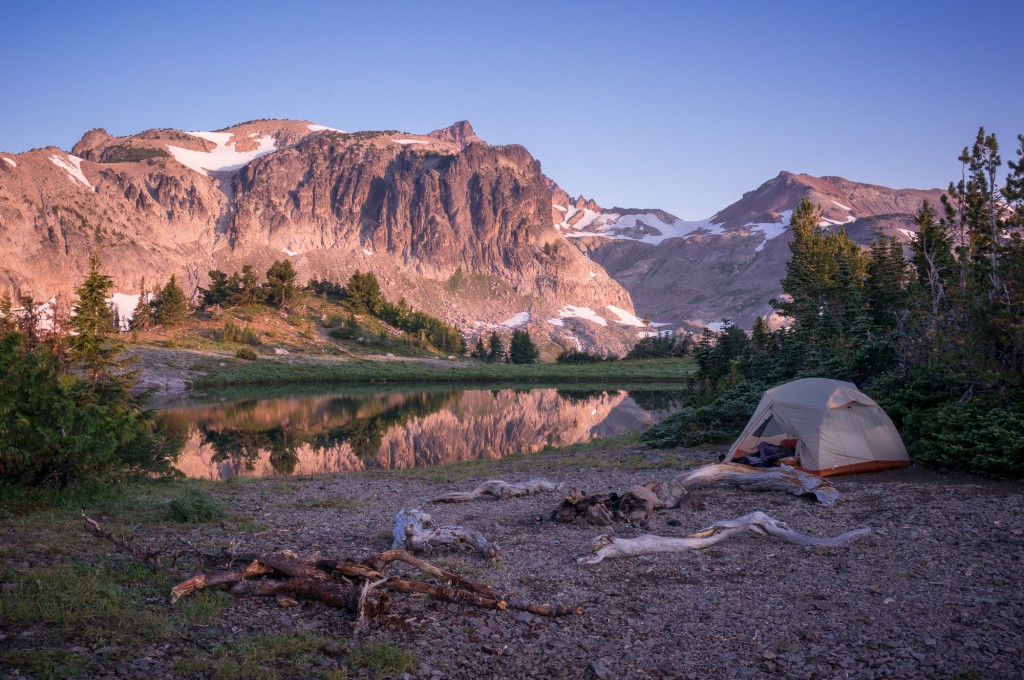
(Photo by Anne Archambault)
We had a grand campsite at Warm Lake that was well secluded, close to water, and afforded an excellent view of the cirque, the ridge, and our next morning’s summit. We ate well, rested our feet, and found a spot to hang our food for the night. In addition to the normal camp chores, we’d also brought a tripod and digital cameras, intent on doing some night photography and time lapse. The moon was set to rise around 11h30PM so I woke up around 10:30PM to set up my camera and leave it running for the rest of the night.
I was a little worried that my all night experiments might not have produced anything. In the end, I think the results are pretty cool and I was happy to work a little at my video editing skills.
Our climb the next day took around 4 hours return to the summit. The trail was a faint and rarely used goat path that followed the obvious ridge to the shoulder of Gilbert.
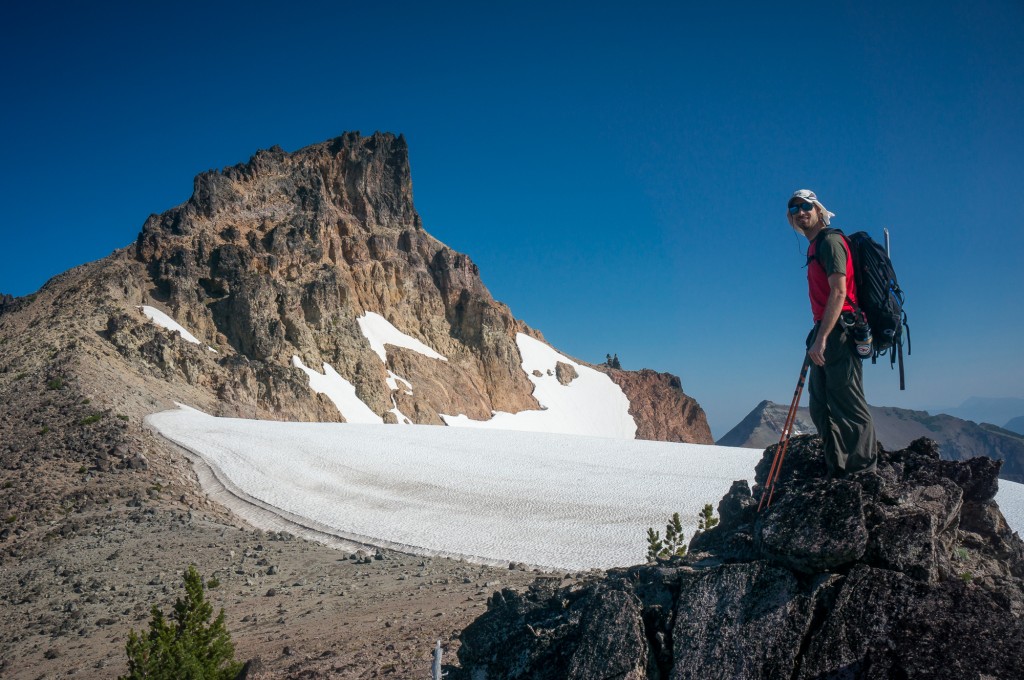
(Photo by Anne Archambault)
This leads to an obvious traverse on the west side of the buttress to a point of weakness in the small but vertical bands of rock. The true summit was attained by heading nearly straight up. On the way up, we met another couple who had been leapfrogging us since we left the trailhead the previous day. They were Mazamas from Portland (Jonathan and Sandy) out for a weekend. We shared the final scramble to the summit, being careful to avoid rock fall as we made our way up the loose slope.
On the summit the views were grand as the Goat Rocks Wilderness was laid out before us along with Mt. Adams, Mt. St. Helens, and Mt. Rainier. We had Jonathan and Sandee take a picture of us rather than our generally mandatory selfie and then made our way back towards camp.

The trip out was uneventful even if it was long, dusty and hot. We stopped to refill our water bottles several times along the way and were glad for the various opportunities to grab fresh (and cold) water. By the time we reached the car around 5pm I was footsore and ready to devour a juicy burger.
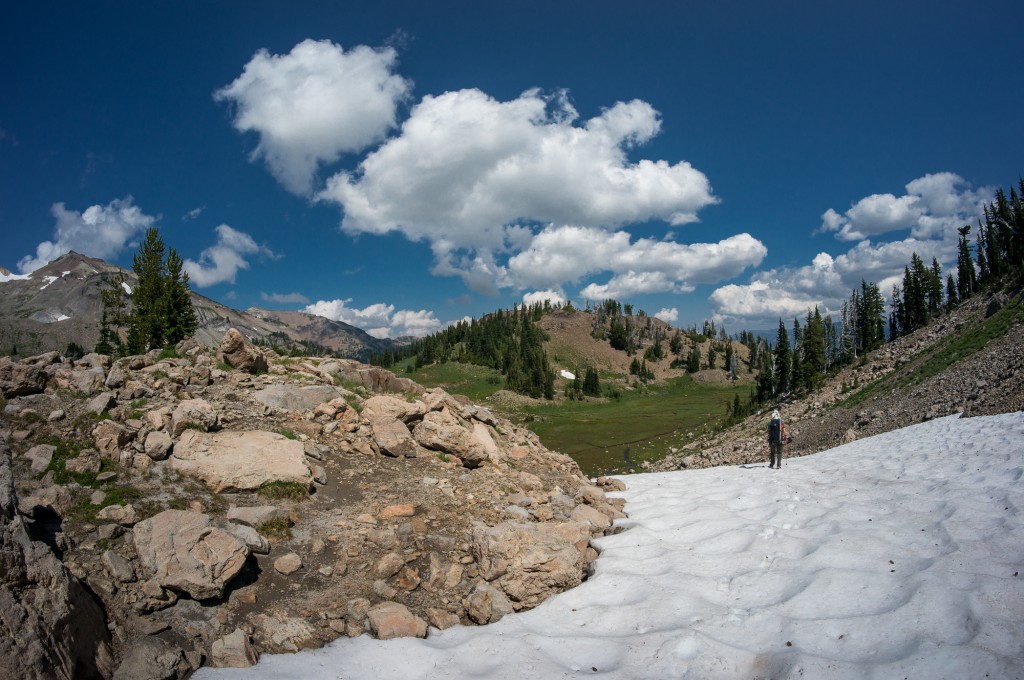
(Photo by Anne Archambault)
Max elevation: 8191 ft
Min elevation: 3880 ft
14
2014Anne and I have talked about climbing the South Sister in Oregon for a little while now. We decided this past week-end to use the excuse of our six-year anniversary to take an extra day off, drive down to Bend, and notch the peak off our tick list.
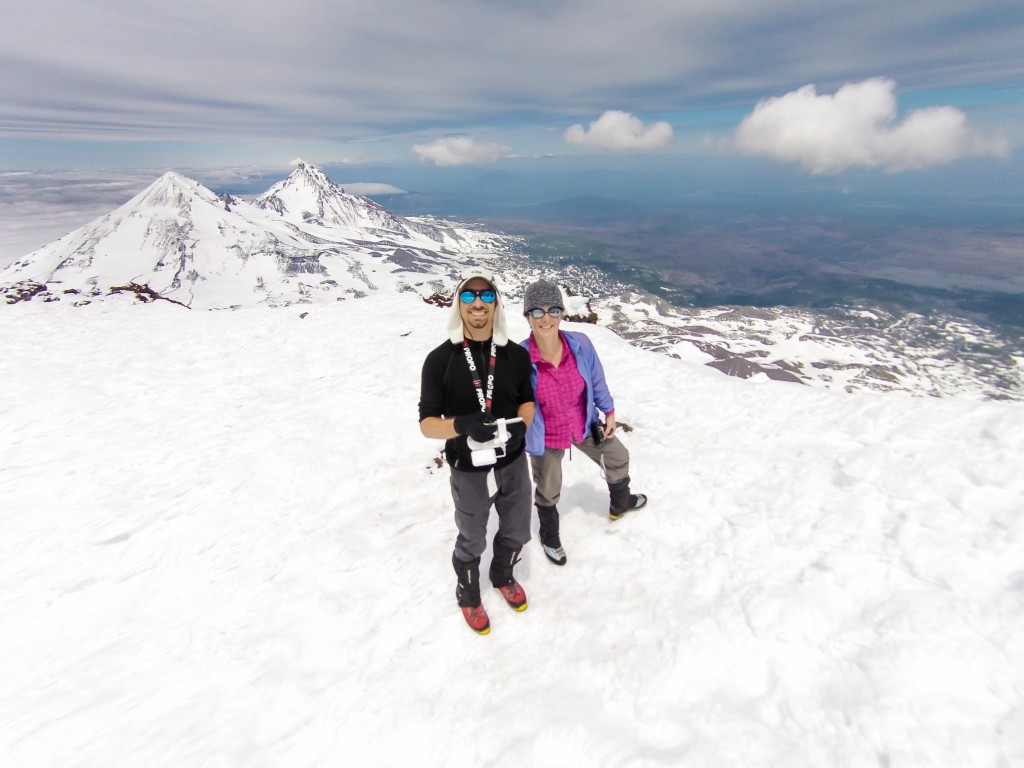
As overnight temperatures were cold, we allowed ourselves a 6am wake-up call that allowed for warm lattes in Bend and a little time for the snow to soften. We packed crampons, ice axes, hiking poles, and the Phantom 2 Vision for some aerial videos and panoramas. After less than a mile, the trail turned to snow and essentially remained snow-bound until the summit. The low overnight temperatures ensured the snow was very firm and in most places easy to walk on without breaking the surface. A low cloud layer (possible inversion) kept temperatures cool.
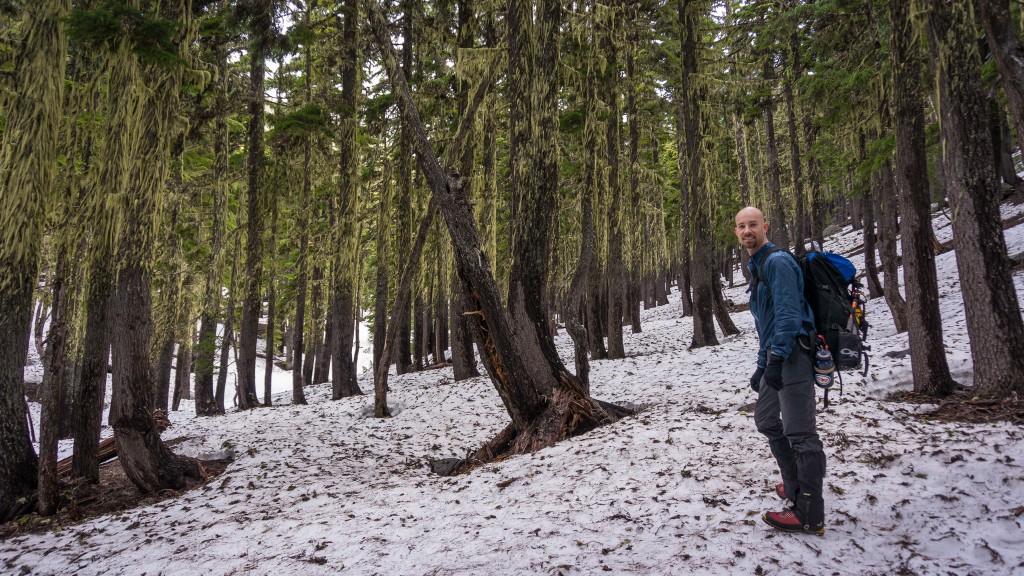
In an enchanted forest (photo by Anne Archambault)
We ascended to the flat section above Moraine Lake where the clouds wrapped around us and limited our visibility. I pulled out my GPS to ensure we stayed on course until we finally peaked above the clouds to a bluebird morning with stunning views of Broken Top and South Sister.
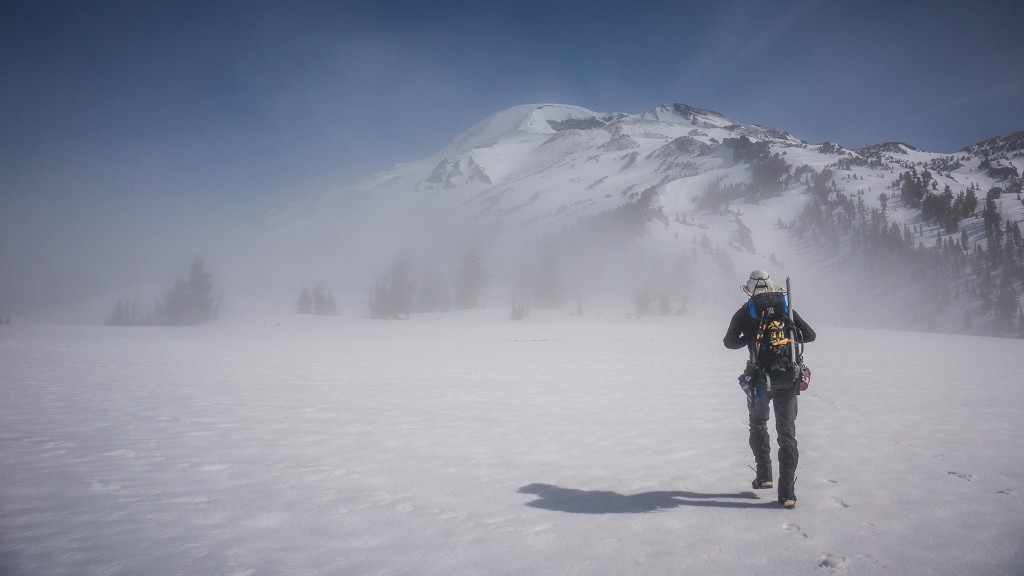
Coming out of the whiteout (photo by Anne Archambault)
The climb itself was relatively straightforward. We made our way up very firm snow and put on our crampons for a short while until the sun warmed the surface enough to ensure good purchase.
We made good time up to the first basin before slowing on the long rock ridge up to the actual summit crater. Here it was clear that some interesting weather had blasted the mountain since the previous weekend. There was significantly more snow on the rib than we saw in photos from a previous trip report and some significant deposits of rime ice.
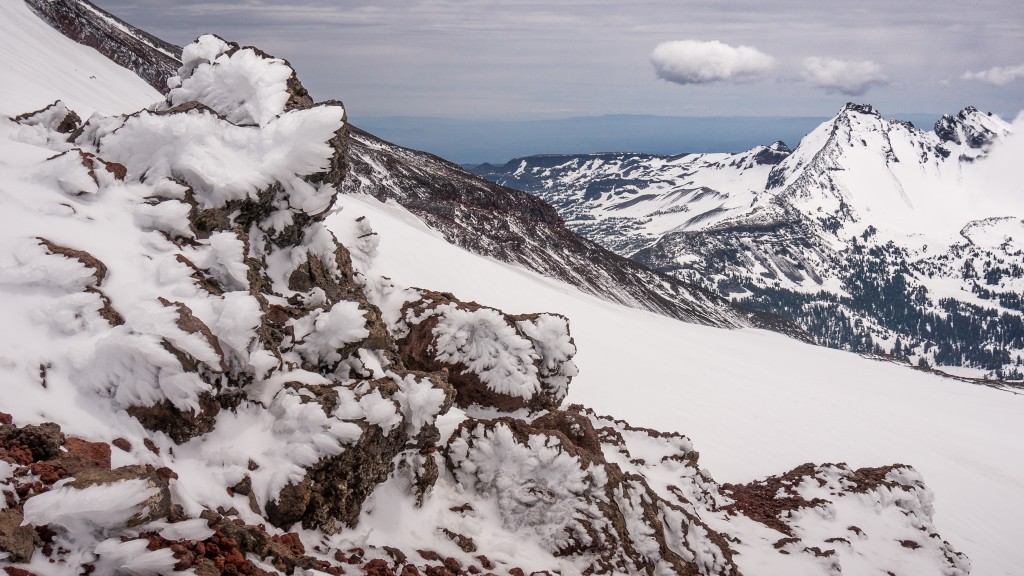
Crazy Rime Ice (photo by Anne Archambault)
The final ascent from the rock rib to the summit involved a steep hill over some pretty firm snow. It wasn’t technically demanding, but the run out was risky at best and offered a somewhat daunting psychological challenge if you looked down and spent time thinking about the consequences of falling. I did my best to kick good steps and move quickly.

Long climb up the rock rib (photo by Anne Archambault)
Cresting the crater rim was exhilarating, the sun was out and the temperatures were surprisingly warm. We quickly completed the final traverse to the true summit and spent the next hour relaxing, eating, and flying the Phantom with spectacular views all around.
The time spent on the summit allowed the snow to further soften for the descent, which made for quality plunge stepping and enabled us to make good time. The soft snow did slow us down by the time we reached the long and tedious flat section. Traversing the flat felt tiring at the end of a long day, but once complete the path wound quickly back to the comforts of our car, sandals, and the inevitable burger and beer in town.
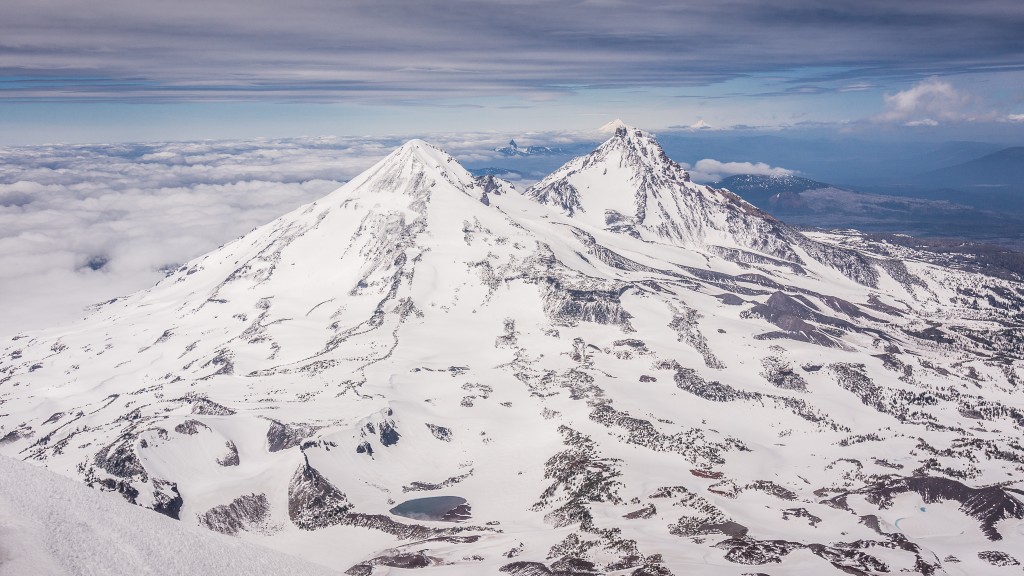
North and Middle Sister (photo by Anne Archambault)
Overall, an awesome summit with spectacular views.
And for those interested, here’s the GPX track:
Max elevation: 10394 ft
Min elevation: 5410 ft
22
2014Anne had a conference in Las Vegas last week so we took the opportunity over the long weekend to visit Zion National Park and hike some canyons. Anne’s always super on top of stuff like this, and like the pro she is was able to get us permits for both the Virgin Narrows overnight as well as the Subway over the Memorial Day weekend. Pretty amazing!
Virgin Narrows
We organized transportation with the Zion Adventure Company to drop us off at Chamberlin Ranch. There’s at least one other company that does hiking shuttles to the ranch, but ZAC allowed us to cancel our reservation if weather turned bad, which we preferred given the advanced scheduling we were doing. ZAC also provides rentals on gear like Five Ten Canyoneer shoes and things like dry pants. While Anne didn’t wind up renting a pair of shoes, we both opted for a pair of dry pants. This was for several different reasons:
- Guidance from ZAC that about 50% of hikers in the Narrows were renting pants
- Water depths were between mid-calf and mid-thigh for most people
- Water temps were around 56 degrees Fahrenheit
- Overnight/morning temperatures were relatively chilly (mid 50s or so)
- The steep walls of the canyon would likely keep the canyon in the shade
We kept a close eye on the water gauge readings, which confirmed relatively low flow and water levels. For those going on the hike, I can confirm that at the rates below the deepest the water ever got was to my waist in one particular hole. Consistent water depth was generally no deeper than my knee (I’m 5’11).
In terms of our kit, we travelled as light as we could on camping essentials to ensure we could carry our camera equipment. In favor of a hot meal, we packed two sandwiches and relied on cold breakfast of beef jerky, nuts, cheese sticks, and Clif bars. Hot tea would have been nice for the chilly morning, but wasn’t strictly necessary. For camera gear, Anne and I both carried DSLR cameras with wide angle lenses (I rented a Nikon 16-35 f4) along with tripods, long exposure filters (6 and 10 stop), and an extra battery. I also carried along a GoPro on an 18” pole for video and such. With tripods, food, water, Steripen, first aid, GPS, sleeping bag, sleeping pad, and clothing my total pack weight was somewhere around 30 pounds.
Because of our particular logistics, we weren’t able to pick our permits up the day before our hike, so we needed to book the 9h30am shuttle, which put us at the ranch around 11am. ZAC’s shuttle runs from the store just outside the park, stops at the East Rim Trail, Orderville, and finally Chamberlin Ranch. Backcountry hikers should be aware that the park asks you to put a small sticker inside your car so they can identify your vehicle should some particular emergency arise. Should you have valuables, it’s a pretty good way to spot who might be gone for a while. That said, people we talked with didn’t seem to indicate petty crime or vandalism was a problem. The shuttle was a 12 person van, which was pretty full and required backpacks to go on the roof rack.
The trail starts simply as a road meandering through the lush upper pasture of the ranch, crossing the Virgin River (at this point really just a small stream) almost immediately and then paralleling the river for a couple miles. After Bullochs Cabin, the road narrows to a path that pretty immediately joins the river for the rest of the hike.
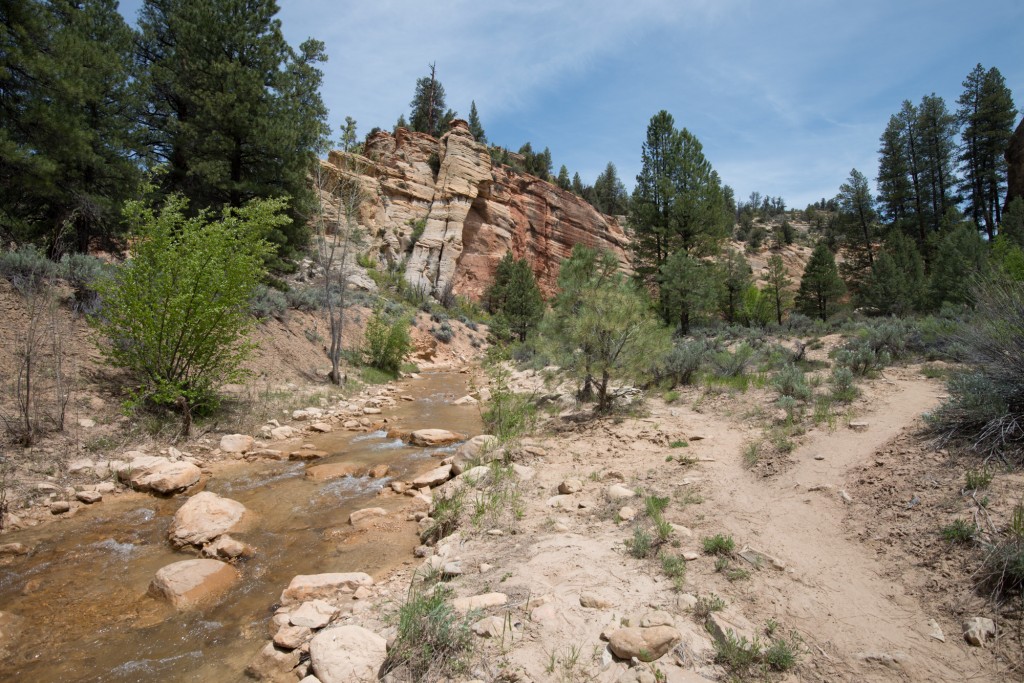
Foot paths repeatedly cross the river for the first couple miles as the valley generally narrows around the river and the walls grow larger. This part of the hike is still quite exposed to the sun and I was unhappy that I’d left my sunglasses behind mistakenly thinking that we’d be sheltered for the duration of the hike by towering canyon walls. The day was warm and so we enjoyed our frequent crossings in the water to help cool off. Water levels here were quite shallow, generally no deeper than ankle or lower calf.
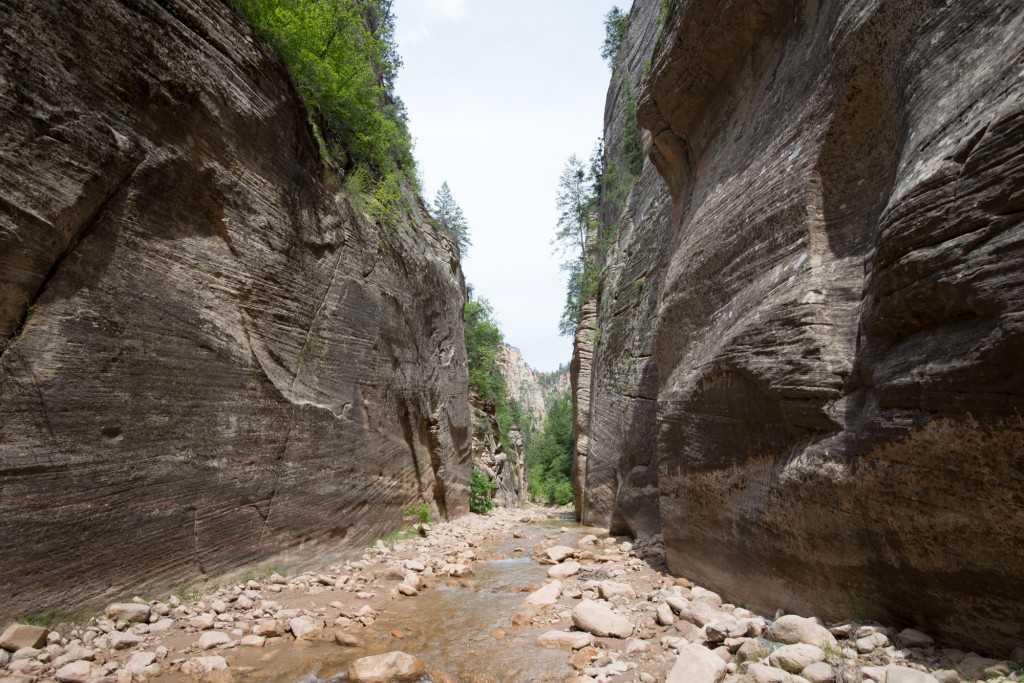
Gradually, the walls continue to narrow until you reach the upper narrows, which close around you like a proper narrows should. These are certainly fun to walk through, a little dark, and keep you in anticipation of the next corner. In short order after the narrow part of the narrows you’ll reach the falls, which can be circumnavigated on the south side (look for a small cairn on the left side of the canyon). This then leads quickly to the Deep Creek confluence, your first opportunity to filter water, and campsite #1 immediately on the left side.
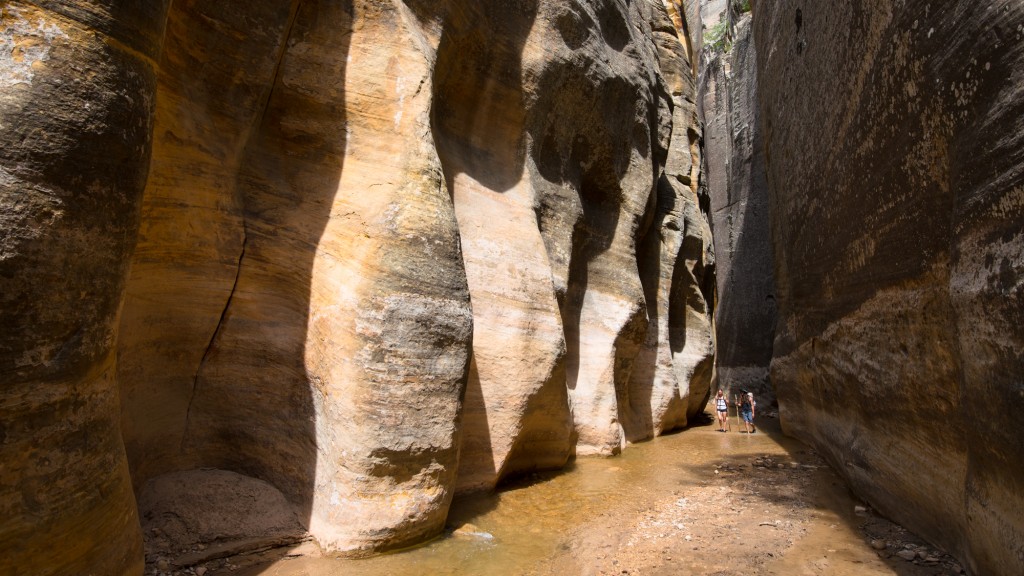
Note: The Park Service recommends only drinking water after the Deep Creek confluence because of the agricultural runoff in the upper Virgin River.
Our campsite was #5, which was almost at the confluence of Kolob Creek. Unlike as shown on the park map, site #5 is not shared with site #4, rather it’s probably a couple hundred yards downstream. Also to note, while the Kolob confluence is hidden from sight when at camp #5, it’s actually just 20 yards down river and should certainly be explored if you have the time/energy. We didn’t know and feel like we missed out. Also to note, sites 2 and 3 had some pretty awesome places to sit and chill, with makeshift benches.
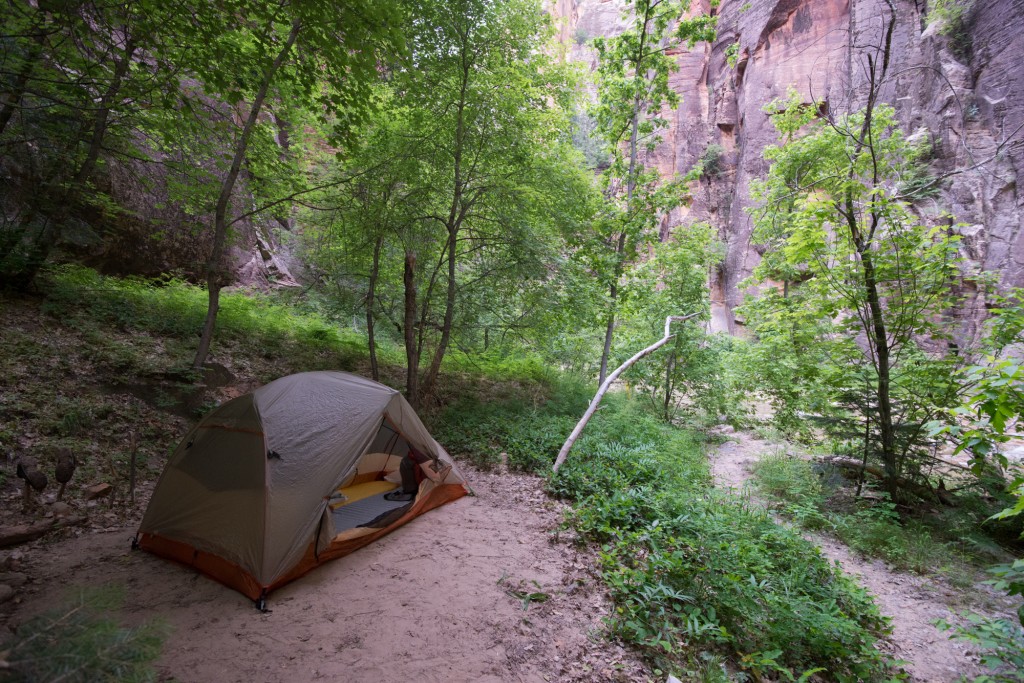
We awoke the next morning to overcast skies. The weather forecast hadn’t been superb and we knew there was a chance of afternoon showers so we moved at a pace that generally precluded taking lots of pictures. This decision was backed up in practice when it started raining on us. However, we soon started meeting day hikers coming up the Narrows from the bottom and that gave us some reinforcement that we weren’t in grave danger of being swept away by flash floods.
The primary narrows on the lower section of the trip was just above the Orderville confluence. The joining canyon is rather small and could almost be missed by hikers coming from the top. For hikers coming from the bottom, this spot marks the beginning of the short section of truly narrow narrows up to Deep Creek.
The trail at this point is pretty much in the river. Where possible, you can hike along the edges of the river course along small embankments or sometimes on well-defined paths in the flood plain. The park service advises against, and has signs to deter, hiking in higher spots along the canyon to prevent erosion. Because the path is more or less over irregular terrain, progress is generally slower than what you’d expect on a maintained trail.

The sun did break near the end of the trip, so we broke out camera, tripods, and the rest of the equipment to capture some of the more iconic spaces in the lower narrows.
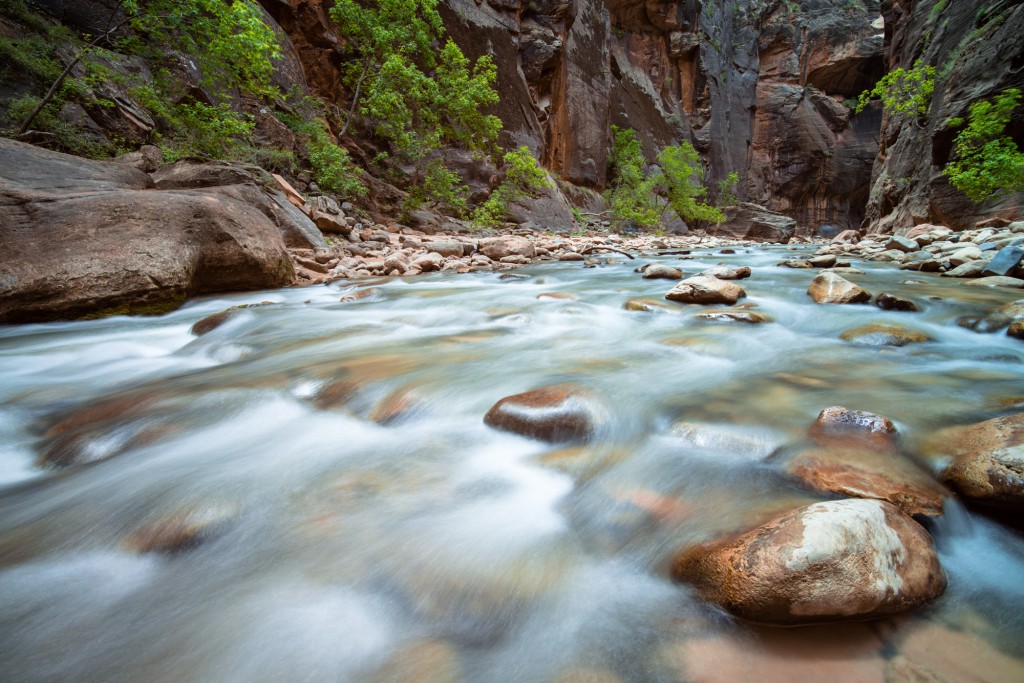
After a few more twists in the canyon, we found that our trip was at an end and we were at the paved trail leading to the Temple of Sinawava. Overall, a pretty grand trip. Anne and I hadn’t been on an overnight trip since this past winter and it was great to get away from crowds and do what many consider to be an iconic hike. While I was hoping for more accommodating weather on the second day, I certainly couldn’t argue with either the water level or generally the temperatures given our use of dry pants. On retrospect, the dry pants were critical for comfort on the trip and were a wise investment (despite the fact that we didn’t use them at all the first day).
Kanarra Canyon
Our next canyon was the Kanarra Canyon in Kanarraville about an hour outside of Zion. The hike is relatively short, has an easy approach, and provides nice narrow and scenic slot canyons with at least two very nice waterfalls and some sporty if not difficult ladder climbing.
Parking for the canyon is in a parking lot at the base of the access road and costs $10 for the day. You can park for free at the city hall, and you should be aware that it’s not permitted in Kanarraville to park on the street (or at least not for visitors).
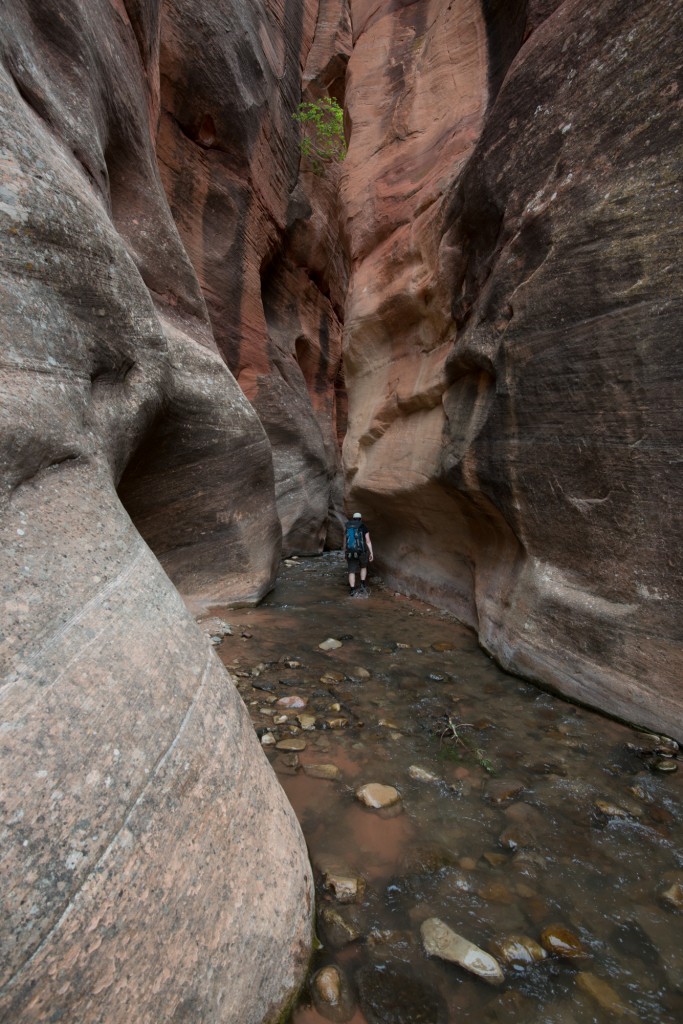
The path follows an access road for a while, gaining, then losing, then slowly gaining elevation again. After about 1 mile (possibly less) the trail joins Kanarra creek, initially crossing it for a short while and finally joining with it. The first slot comes up rather suddenly and is narrow, somewhat tall, and completely fun. This ends quickly in the first waterfall that is well provisioned with a “ladder” that allows hikers to climb up to the top.
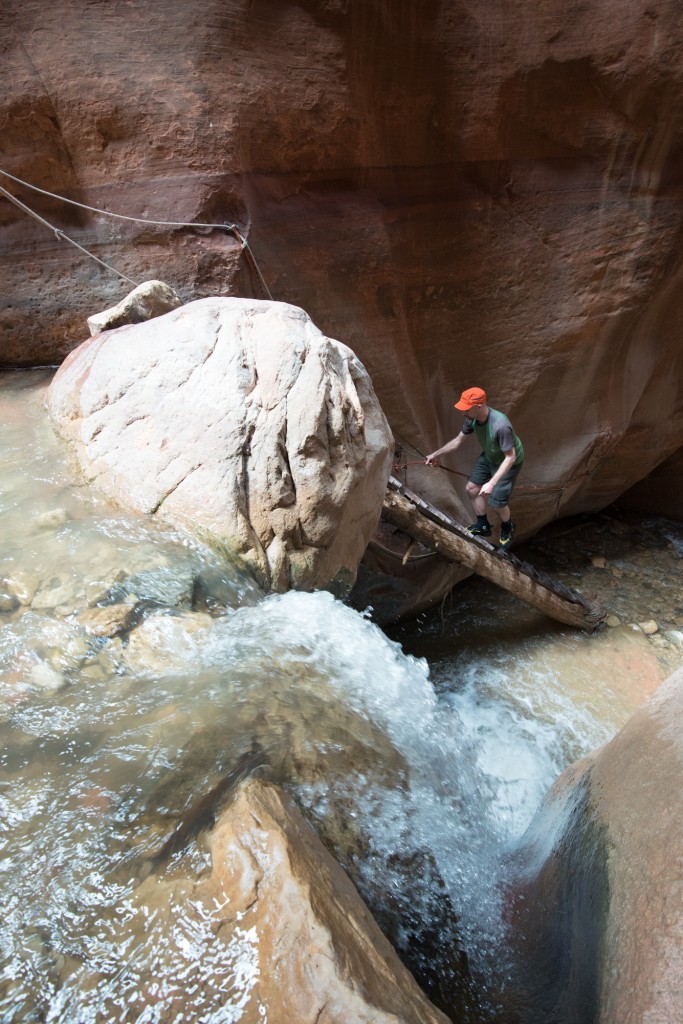
The next section works past some slide debris, through a wider area of the canyon before coming to some slick rock falls (and a nice natural water slide), a side canyon confluence, and the second of the narrow sections of the canyon that leads to the second waterfall. Here the ladder consists of a two rung wooden ladder strung up on the rock with a set of ropes. The whole contraption is somewhat unstable but has foot loops, hand loops, and knots to make the ascent completely possibly if somewhat ungainly. This is where we stopped and turned around.
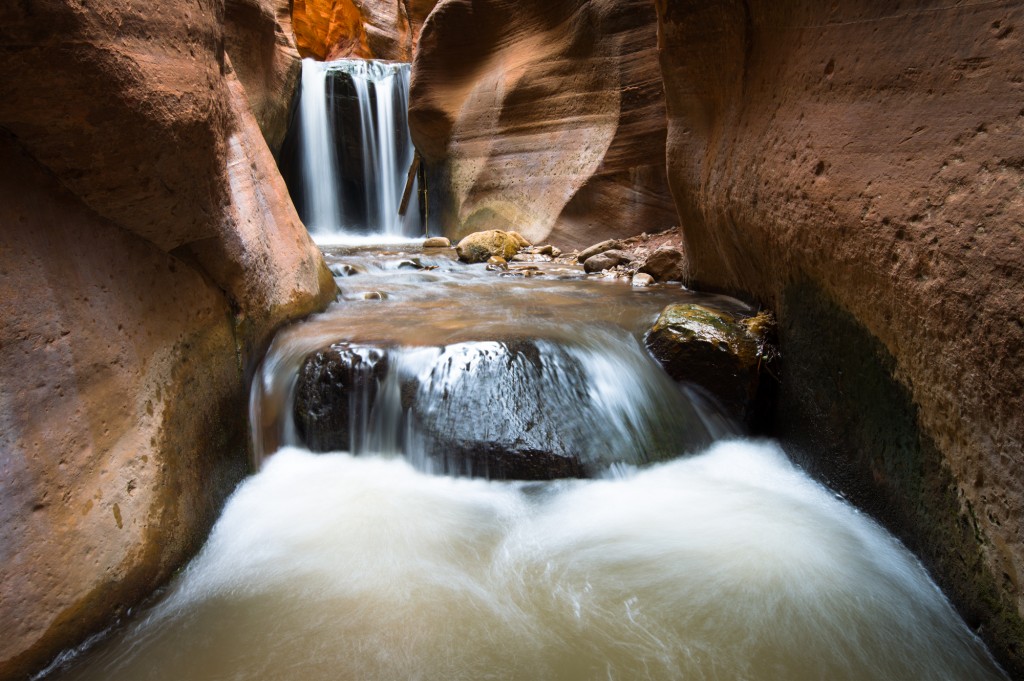
In terms of bang for the buck, it felt like it was pretty hard to beat Kanarra Canyon. Access was short without a lot of elevation gain, there are a couple very nice narrow sections to the canyon, and there are a number of water features that could keep photographers occupied for hours. For families, there are a couple nice pools to cool off in, a great area for lunch, and a natural water slide. Overall, I thought it was an excellent canyon.

The Subway
Our final canyon of the trip was the venerable Subway. We chose to do the canyon as a round trip from the bottom given our photo gear though most of the traffic we saw during the day (at least 40 people) came from the top as a true wet canyon trip.
We read one description of the bottom up round trip route as not being worth the effort. It proclaimed the hike as disappointing if you only come to look at the Subway and implored readers to do other hikes in the park. After hiking the trail, it’s somewhat hard to disagree. The hike in is laborious and in the sun it’s also hot. Because most of the trail follows the river, it’s constantly criss-crossing the water and rock hopping. That said, Anne and I both had times where we were able to lose ourselves in the beauty of the place.
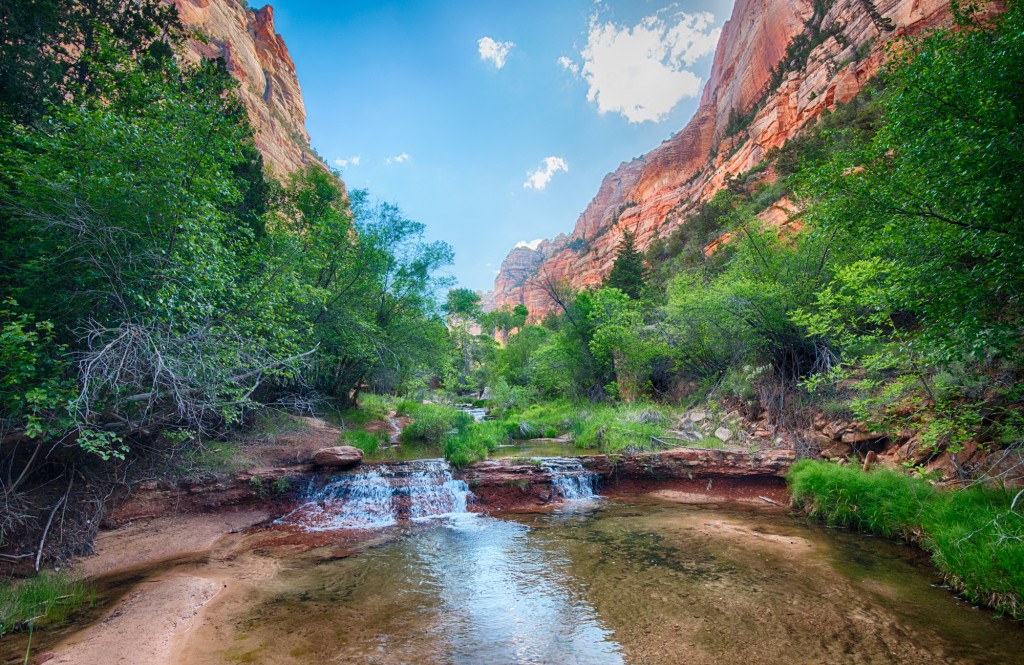
The bulk of the trail can be done dry, and until the last half mile or so we hiked in our normal hiking shoes. Once we reached the slick rock formations, we transitioned into our wet shoes (for Anne these were sandals, for me it was a pair of Five Ten Canyoneers). Once wet, I did the rest of the trip in my wet shoes. On hindsight, I should have only carried a single pair of shoes (the Canyoneers) and saved myself the trouble of keeping my feet dry on the way in, which would have made route finding easier.
Of course the highlight of the trip is the Subway formation itself. This comes at the very end of the outbound trip and is really just the last 100 or so yards. Given the name and the pictures I’d seen, I had expected the rock to overhang the formation more. However, careful placement of the camera can provide the illusion that the Subway is somewhat more covered and subterranean than it actually is.
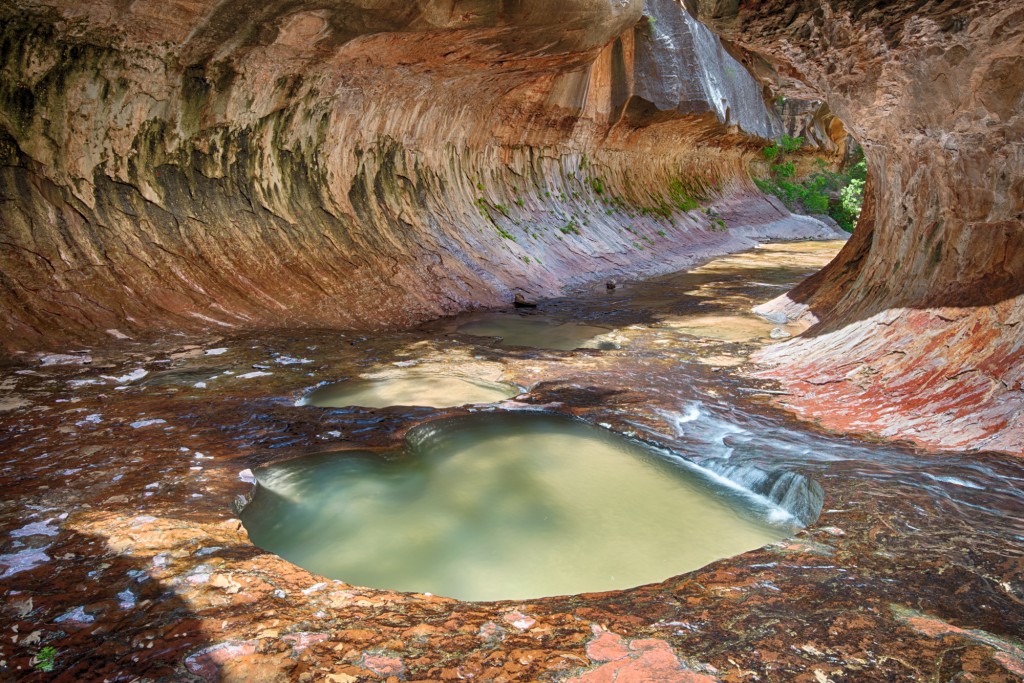
Time of day is also important. Because the trail in took us longer than expected, we arrived shortly before noon when harsh sunlight was streaming directly down into the slot. It turns out that the best light for the Subway is either mid-morning or mid-afternoon, which helps soften contrast inside the formation while helping to light the “entrance” and “exit” of the formation. Unfortunately, we needed to leave before the afternoon sun the right location.
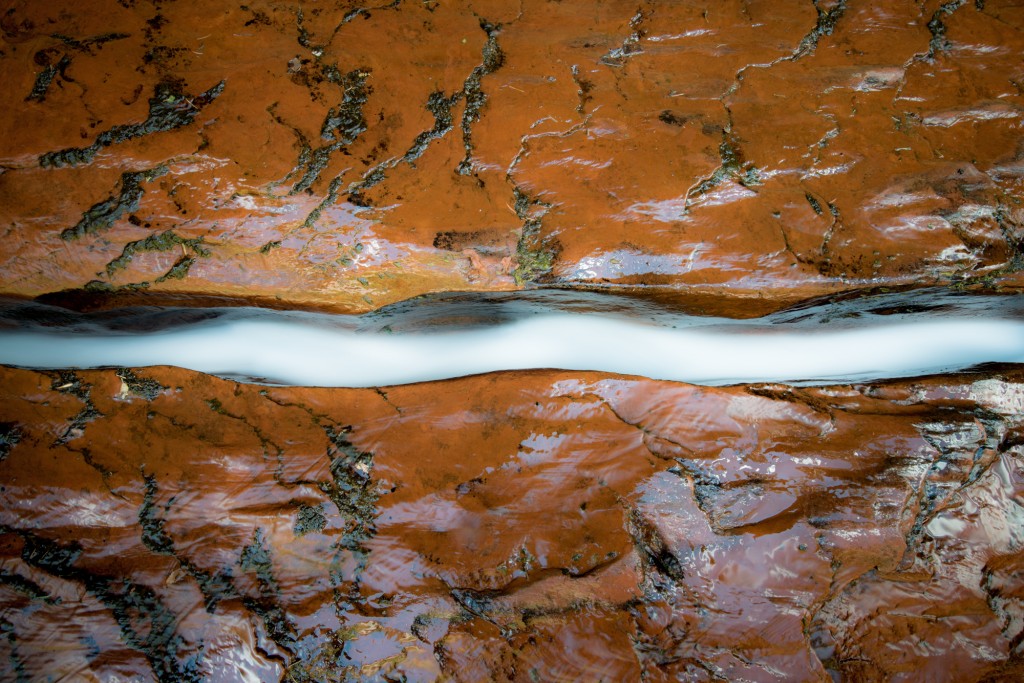
The second highlight of the trip was the slick rock formations and waterfalls. There is a small channel in the rock, literally around the corner from the Subway (possibly 200 yards downstream) that’s also a popular photography subject and one that Anne and I spent a lot of time photographing. This location is best in the morning while the rock is still in the shade. When we left around 3, the light was directly on this area and quite harsh.
Summary
While I’ve visited Zion National Park previously, I never felt like I’d truly explored the park in a way that wasn’t just superficial. This trip allowed us to see some of the classic sights of the park, get some great photos, and simply enjoy a wonderful long weekend in a spectacular area of the country.
07
2014Day eleven marked the last true day of “tough” hiking with a route that lead over the Augstbordpass and into the Mattertal valley to St. Niklaus. We woke early, grabbed a filling breakfast, and headed out into the cool and overcast morning. For the previous couple days, the weather had been starting to turn more seasonal, both cooling and becoming more overcast.
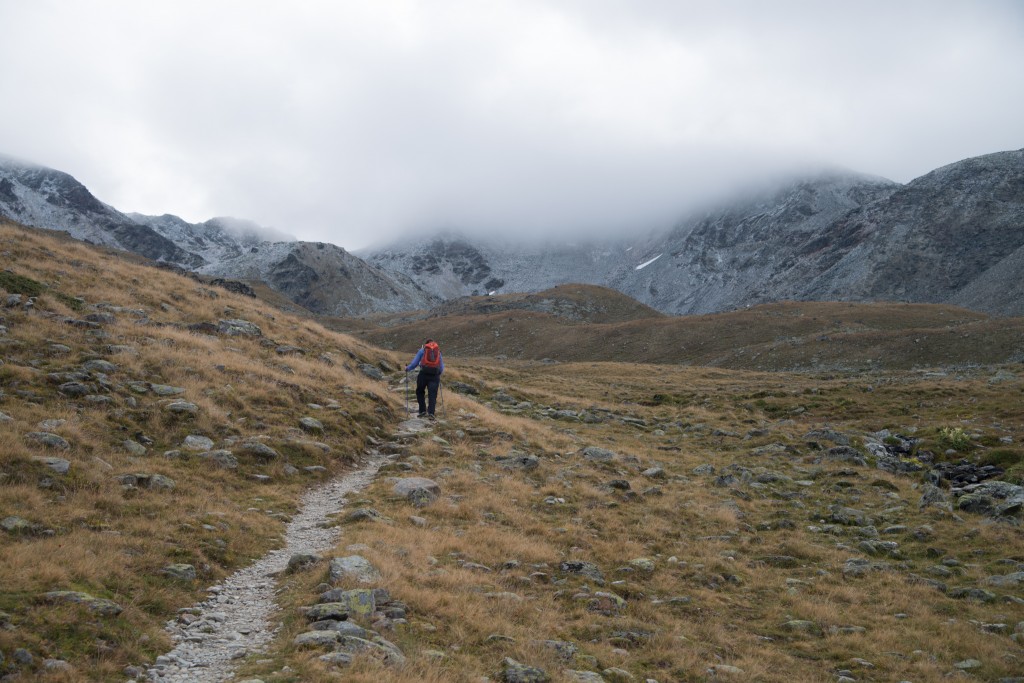
The hike itself goes virtually straight up towards the col, heading steeply up the side of the valley before following a smaller valley up to the Augstbordpass. As we climbed, the views back over the valley opened up and we heard the characteristic clang of cow bells as herders brought back in their cattle for the season.
At one point, a young man passed with a small herd of cattle following. Anne and I stepped off the path to allow the caravan to pass and were viewed inquisitively by the passing bovine.
As we headed up the valley, the wind picked up and the temperature seemed to drop.
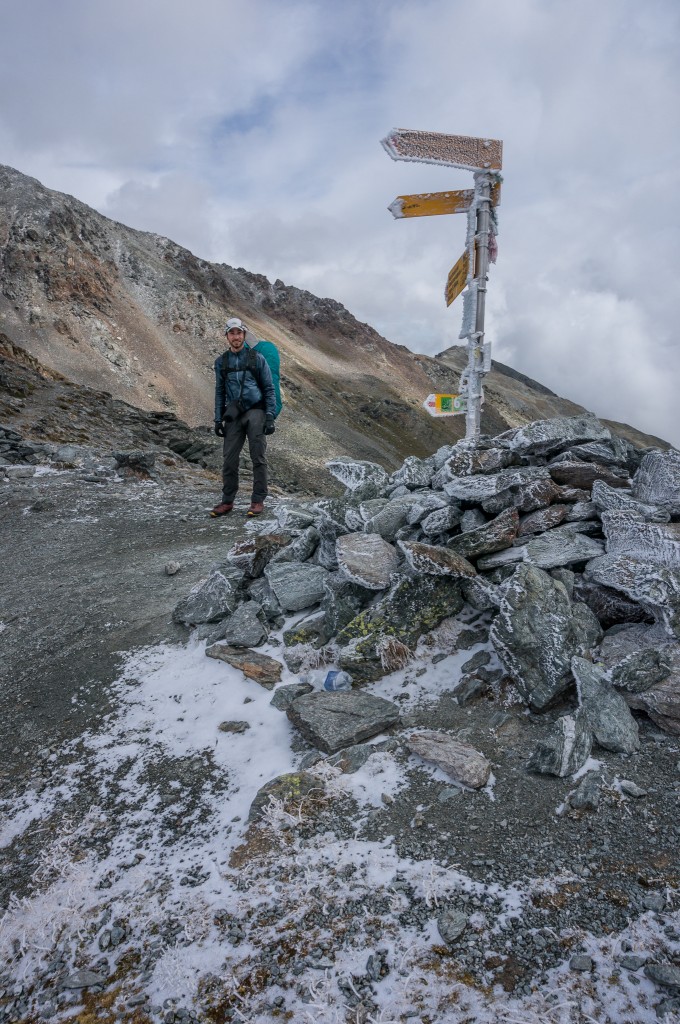
The final climb to the pass was bitterly cold with rhyme ice covering the plants, rocks, and sign posts. We stopped quickly for the obligatory pass photo before dropping down into the Mattertal in search of a respite from the biting wind and cold.
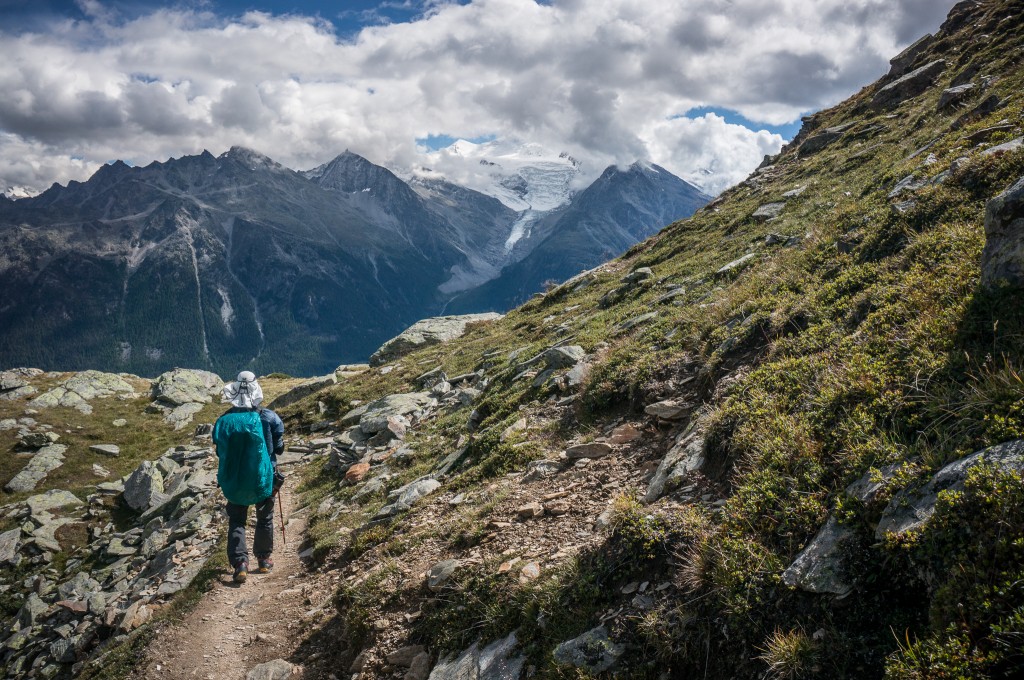
This path descends directly down a small side valley before cutting sharply right and traversing along the valley side along a mostly scree slope that is sometimes exposed. The slight amount of gain is rewarded handsomely at the Twära overlook.
The path from the overlook led relatively directly and steeply to the small town of Jungen. While it was possible to see Jungen a short while after passing the Twära overlook, it took considerably longer than expected to actually reach to the town. Here we ran into Rich, Denise, and Brian eating at the Junger Stübli where we sat down to rest and enjoy with them for a short while. Take note, there is a room for let in the Stübli and if you have the time you should certainly try for it since it would afford excellent views in one of the most beautiful small Swiss Alp villages I’ve ever seen.
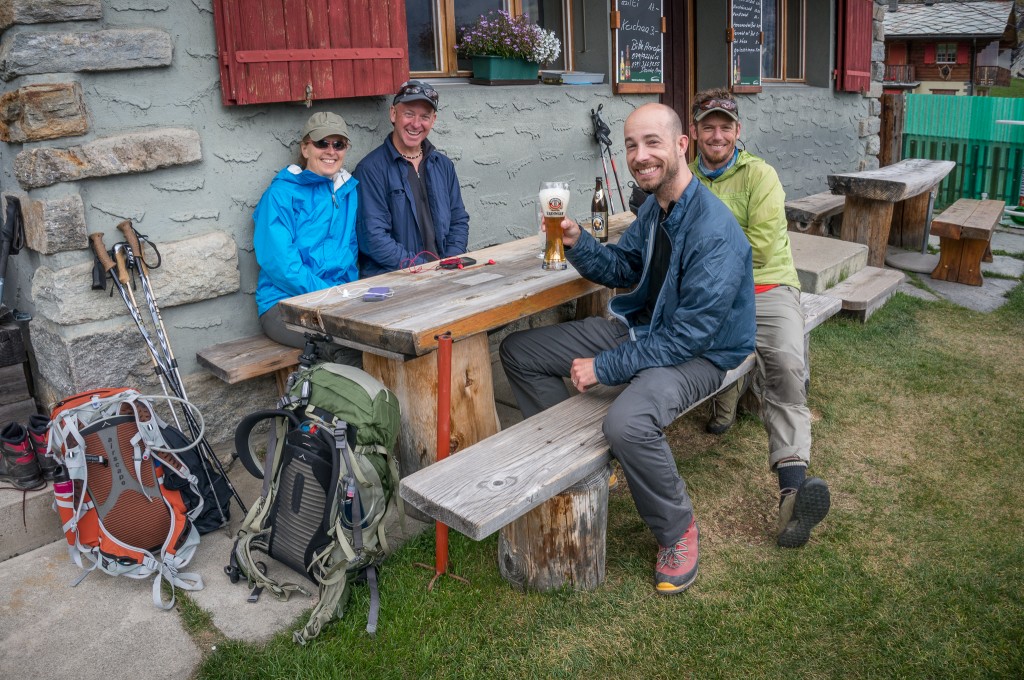
The rest of the path to St. Niklaus was relatively straight forward and took about an hour to complete with our sore legs and tired backs. Arriving in St. Niklaus, it’s a little easy to get overwhelmed with the size and complexity of the town having just spent over a week in very small villages. We had to ask directions to make it to our hotel at the south end of town but we arrived soon enough and settled into our room, happy to be one day away from our final objective of Zermatt.
Max elevation: 9485 ft
Min elevation: 3665 ft
